CRITTERS AT
BRAZOS BEND STATE PARK (AND ELSEWHERE)--LIZARDS PAGE 2
This page was born 09/04/2024 (split off from the
original lizards page). Rickubis designed it. (such as
it is.) Last update: 10/24/2024
CLICK HERE FOR LIZARDS PAGE 1
Go back to my
home page, Welcome to
rickubis.com
Go back to the RICKUBISCAM page.
----------------------------------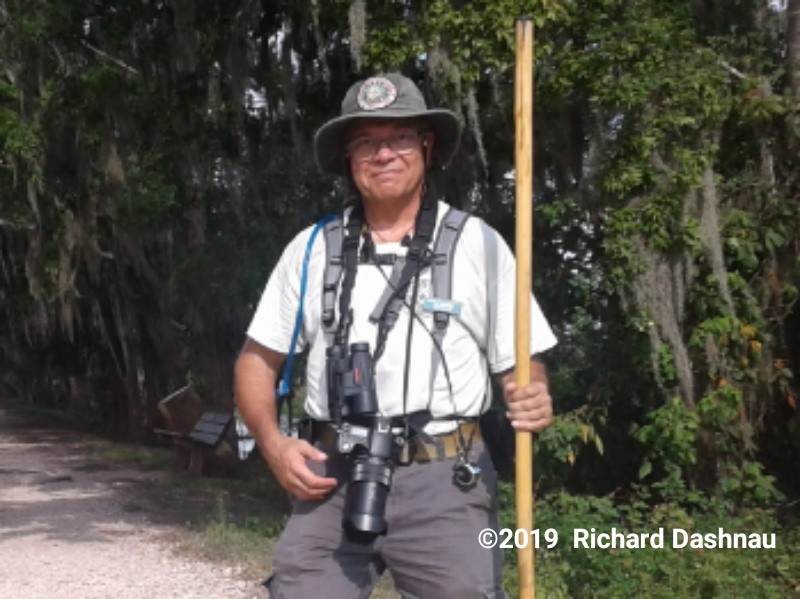
That's me on the
Spillway Trail at BBSP in 2019. Welcome to my second page
showcasing lizards! I've gathered enough to start putting
them on a separate pages. With so many
images gathered, it's best top split off into a new page. I've
noticed that most of the lizards on these pages are Anoles, but
I can't help that. They're still fascinating, and I'll always
have a fondness for them, since I had them as pets during
my childhood. It was (and is) such a treat to seem them running
around wild since I've moved South almost 50 years ago.
09/17/2024 Another
day at the waste container, and this time a single Cuban (or Brown)
Anole (Anolis sagrei) was hunting. This one was also
running up and down the sides of the container, as the Anolis
carolinensis had been doing a couple weeks before.
This
short video is
made from
clips that
I
filmed at high
frame rate as
the Anole
worked. These
two images
clearly show
the prominent
lines and
patterns that
distinguish
this species
from the Green
Anoles
-which don't
have such
prominent
markings
(although
female A.
carolinensis
sometimes have
a single
irregular line
along their
spine).
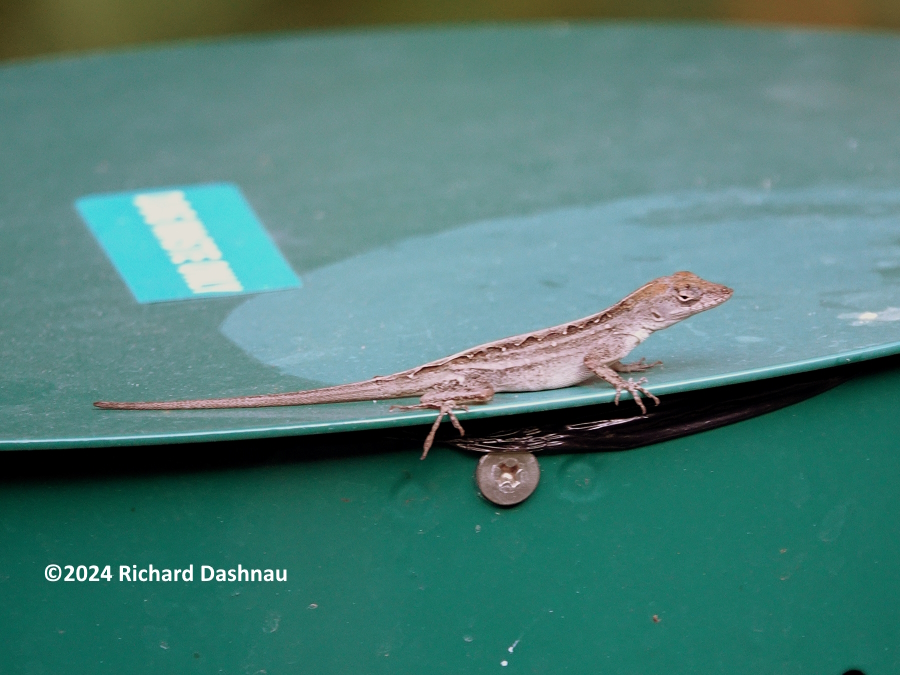
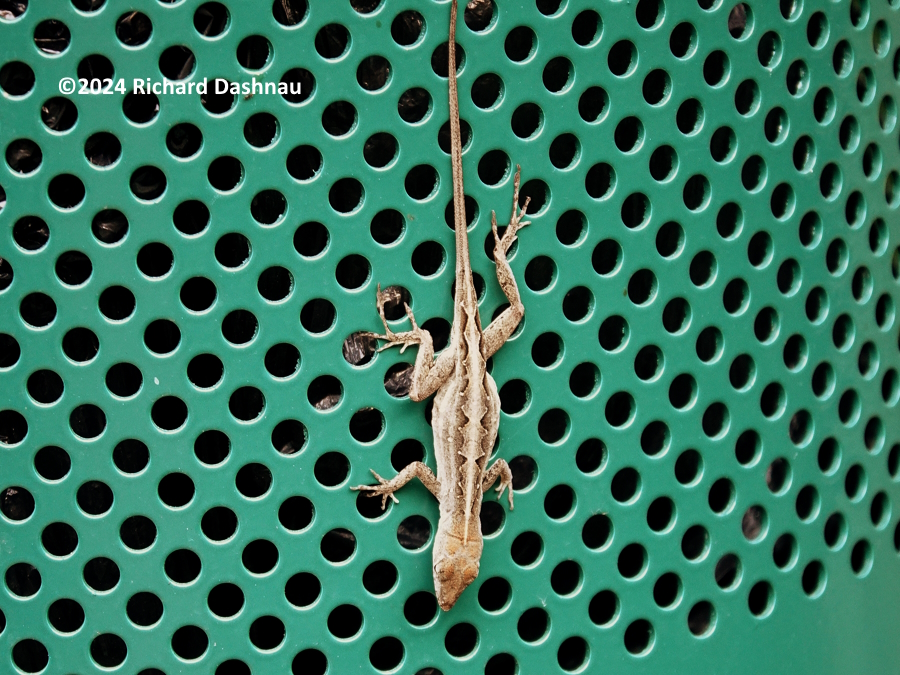
09/11/2024
I
pass the poop
container
often, and
today, there
was a Green
Anole (Anolis
carolinensis);
and one of the
competitive
species of
Anole,
the
Cuban
(or Brown)
Anole (Anolis
sagrei)
hunting on the
container.
Both seemed to
be be females,
and I only
watched them
for a short
time. Still,
it does show
that even the
Brown Anoles
can hunt on
the same
surface. Both
species have
adhesive toe
pads, but I
have read that
the Brown
Anoles have
less adhesive
surface.
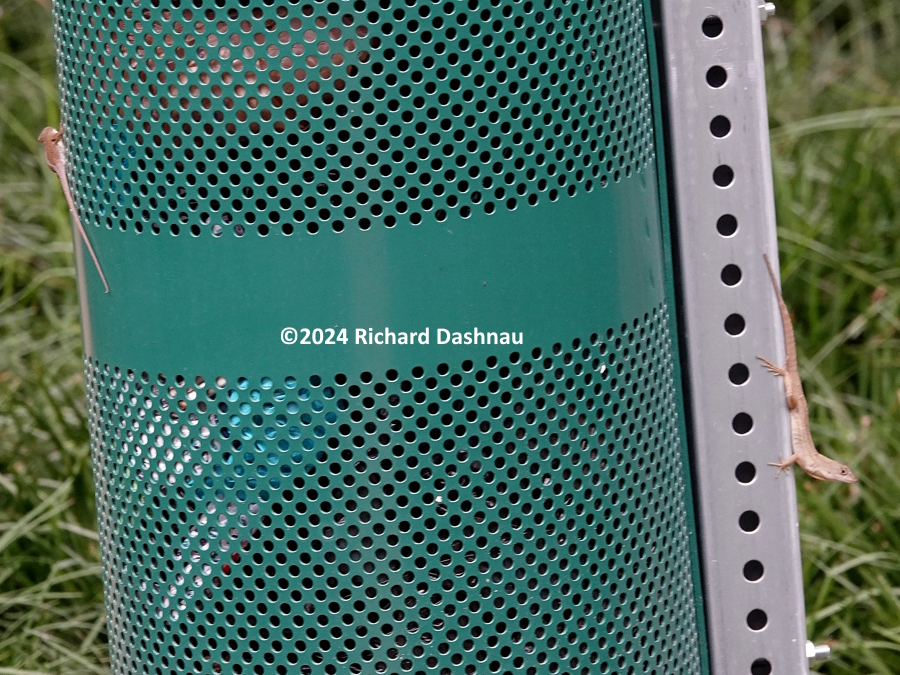
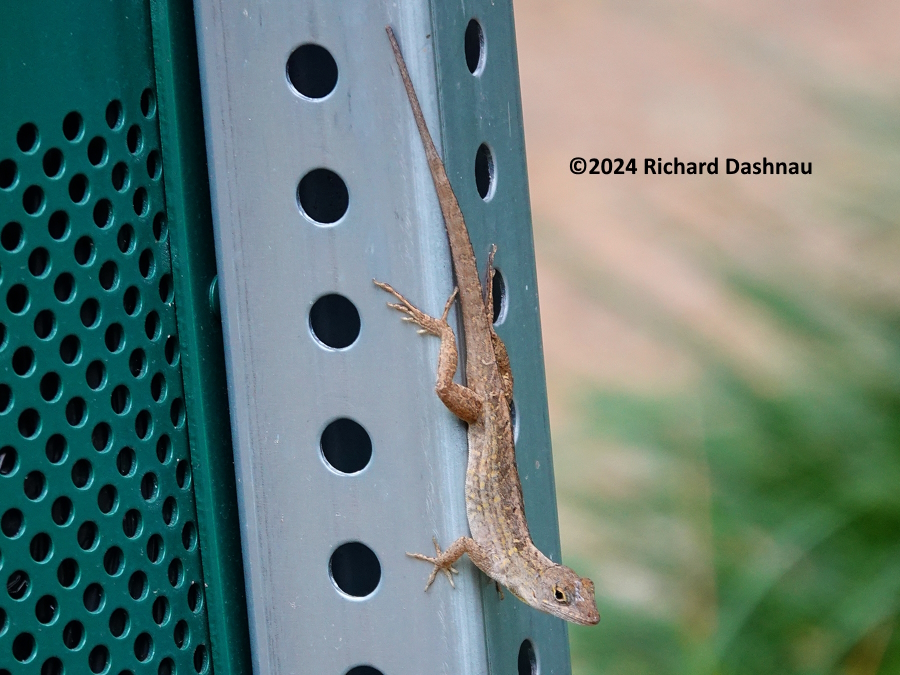
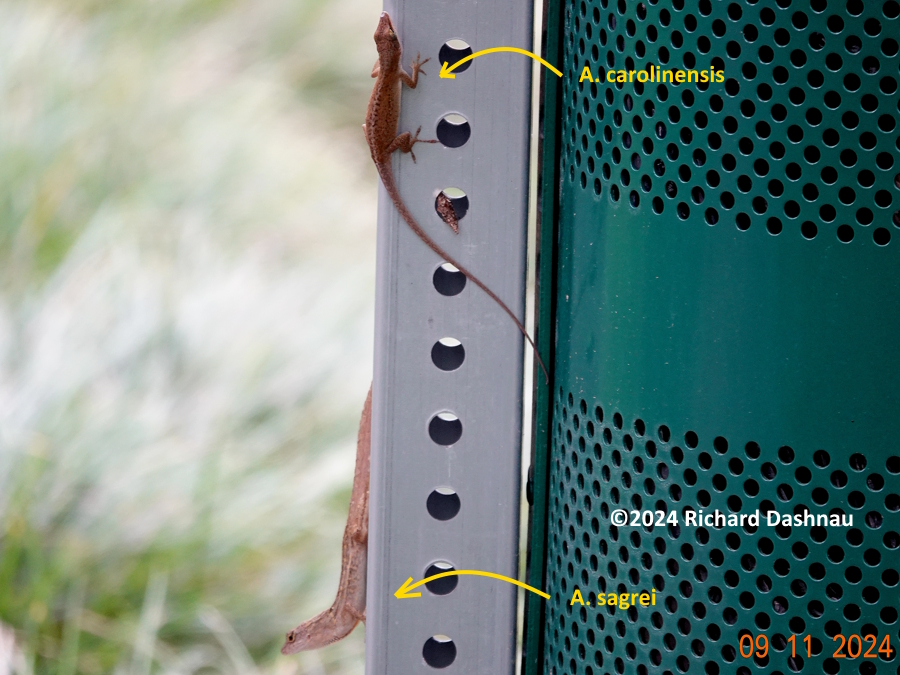
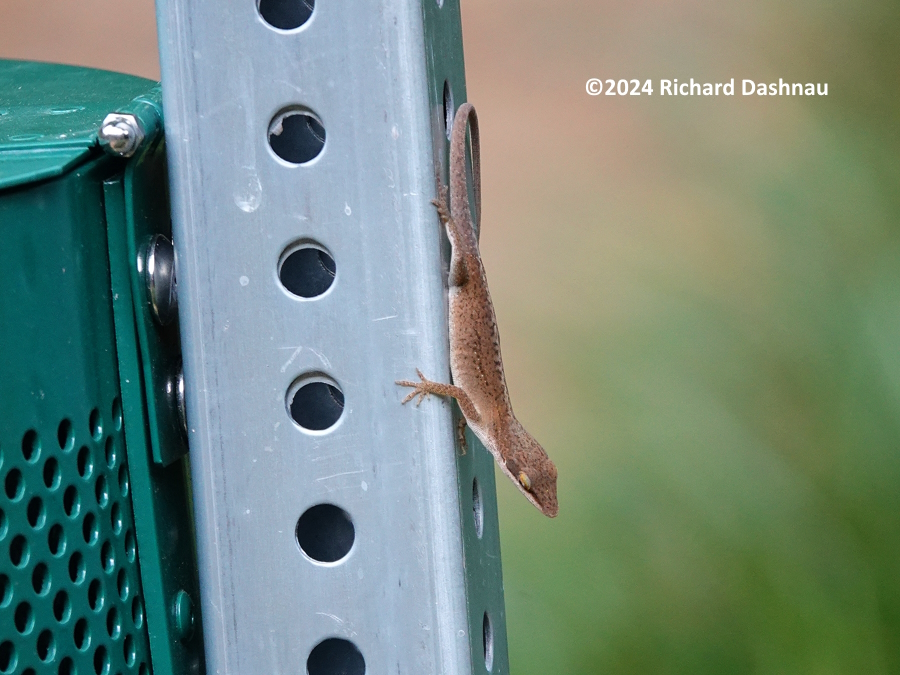
08/24/2024
There
are posts that
have a waste
container, and
a supply of
dog waste
bags. These
stations
should
encourage
folks to pick
up the waste
left
by their
dogs. I
noticed that
Anoles were
often perched
on one of the
containers,
and realized
that they were
probably
hunting flies
that were
attracted by
the waste
inside
the
containers. I
chose a day
that had a few
lizards, and
watched with a
camera. I got
the images
below and this
video is made
from clips
I got that are
edited
together.
I filmed from
some distance
away so I
wouldn't scare
the Anoles.
These are
Green Anoles
(Anolis
carolinensis);
which are
relatively
rare in my
neighborhood.
Most of the
time I see the
competitive
species of
Anole, the
Cuban (or
Brown) Anole
(Anolis
sagrei). I see
those everywhere.
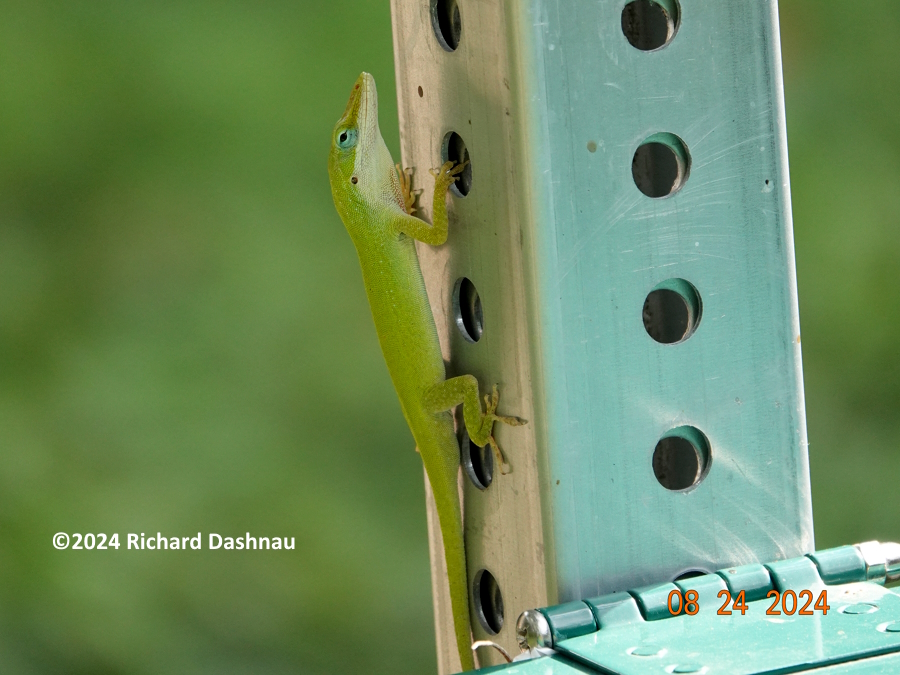
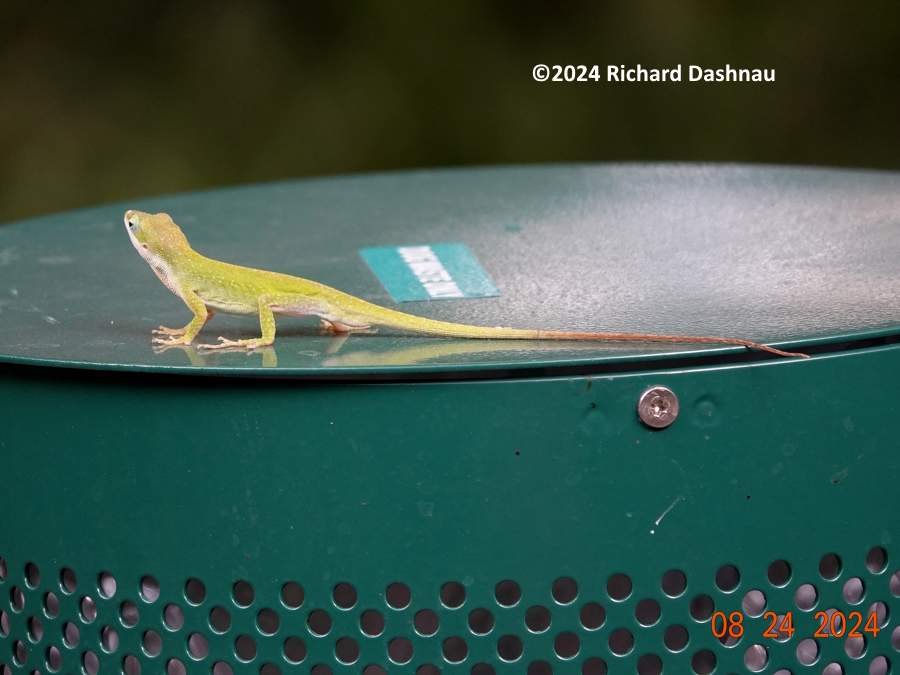
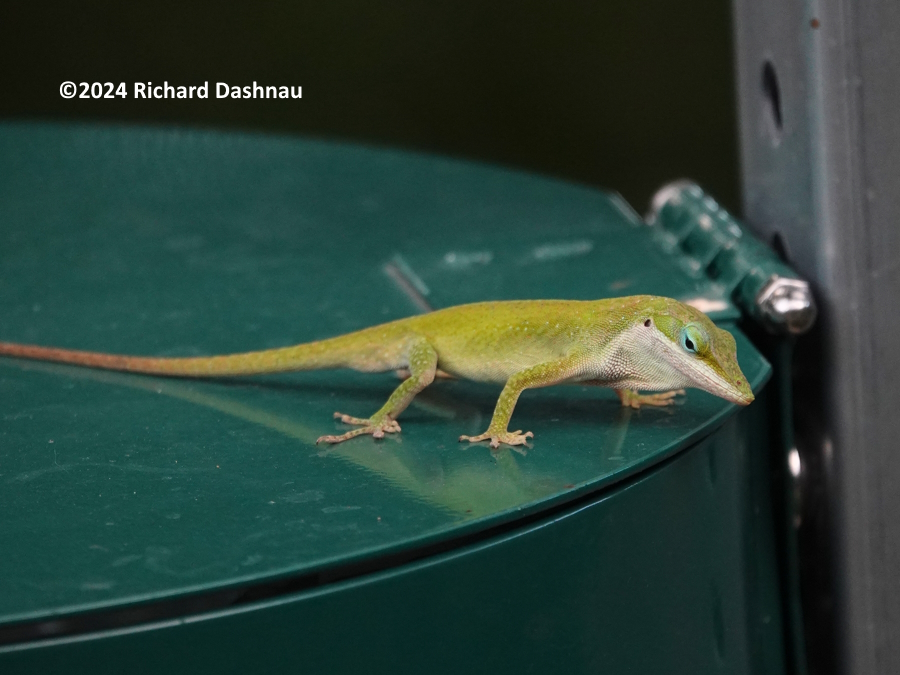
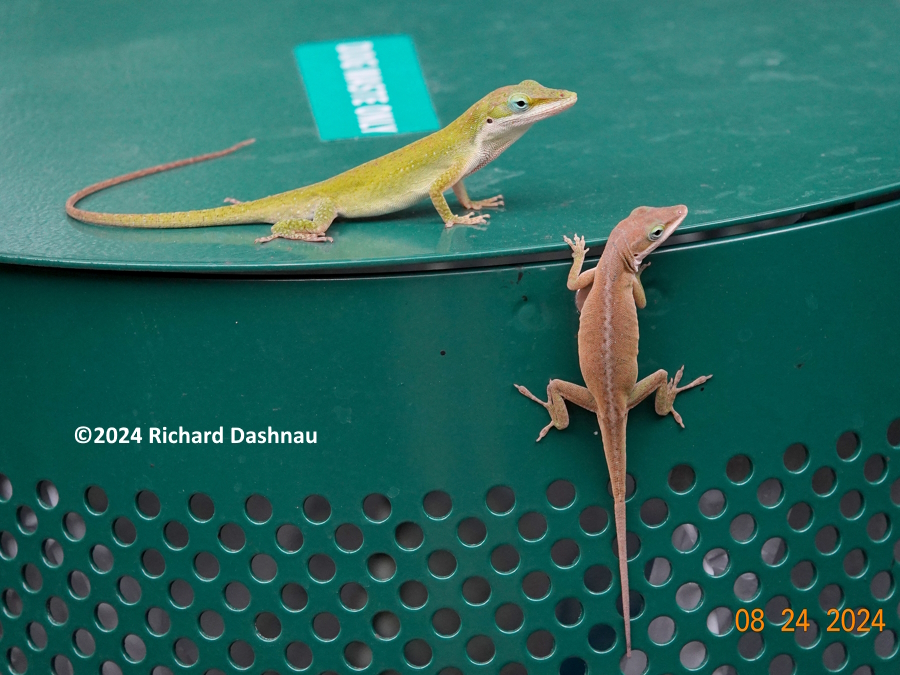

This
male broadcast
his presence.
The ends of
the Anoles'
toes are broad
pads. In the
slowed videos,
take note of
what the
Anoles' toes
are doing.
While watching
the
slowed video,
it's easy to
forget that
these lizards
are crawling
on vertical
surfaces as
easily as on
horizontal
ones.

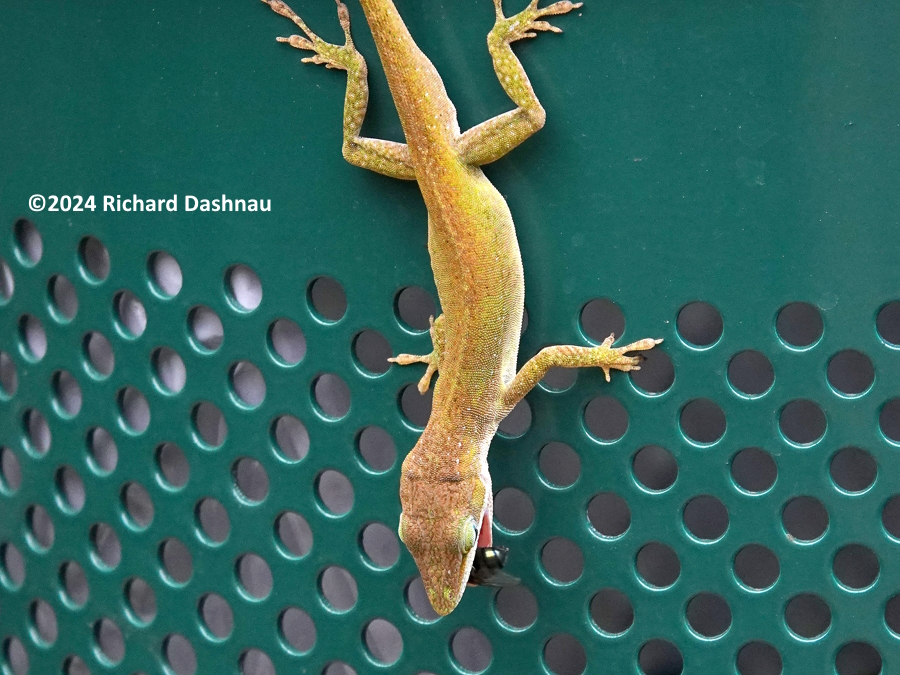
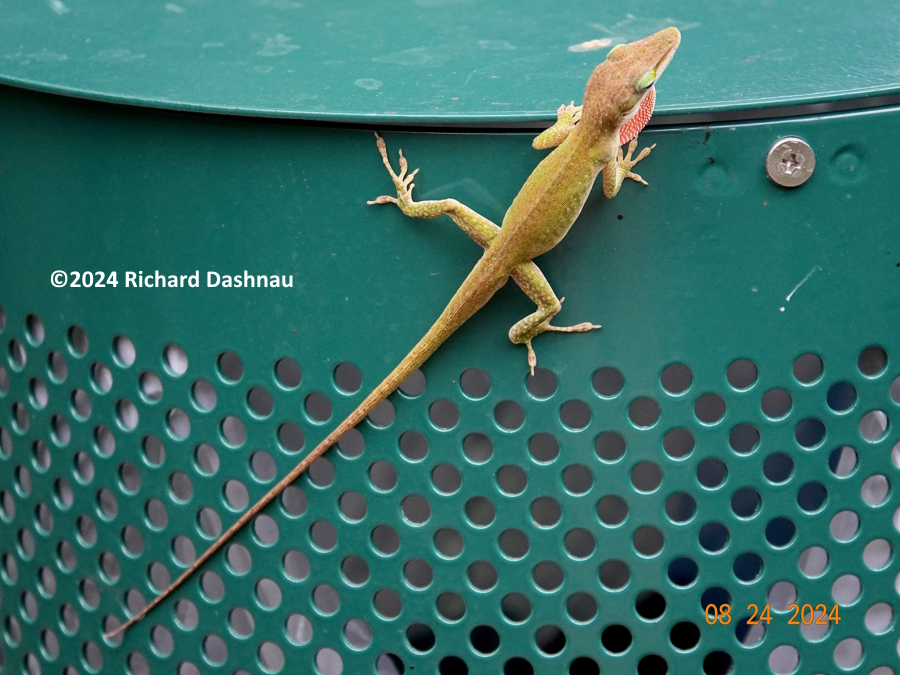
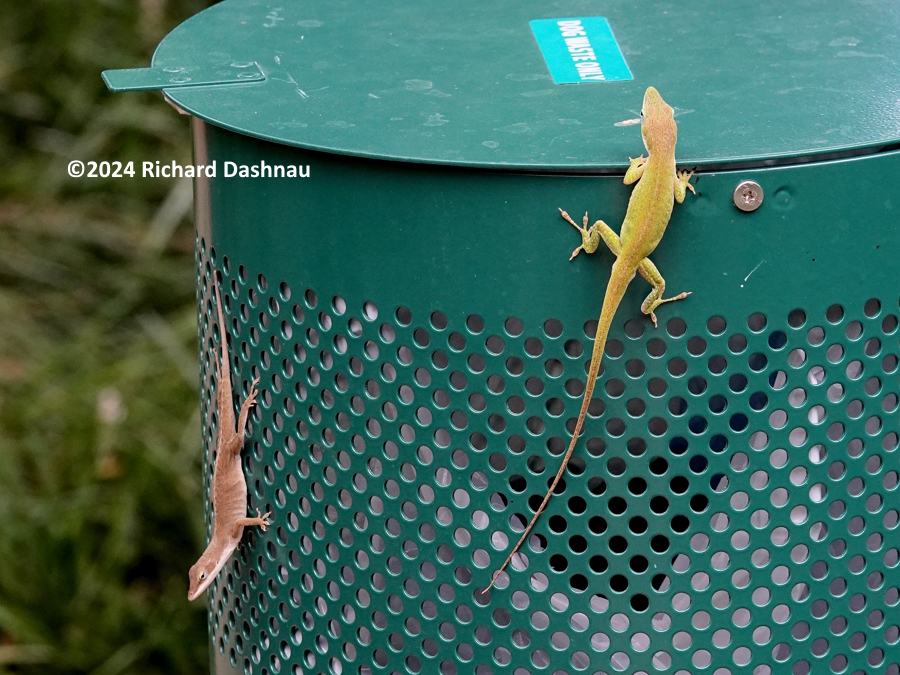

Even
after the
lizard changed
from vertical
to horizontal
movement, its
toe-pads still
cling. The
pads are
covered with
hundreds of
tiny hairs
that adhere by
molecular
attraction.
The Anole has
to peel its
toe tips up to
move its feet.
In the slowed
video, we can
see how the
Anoles extend
just the
sticky tip of
their tongue
before leaping
at prey.
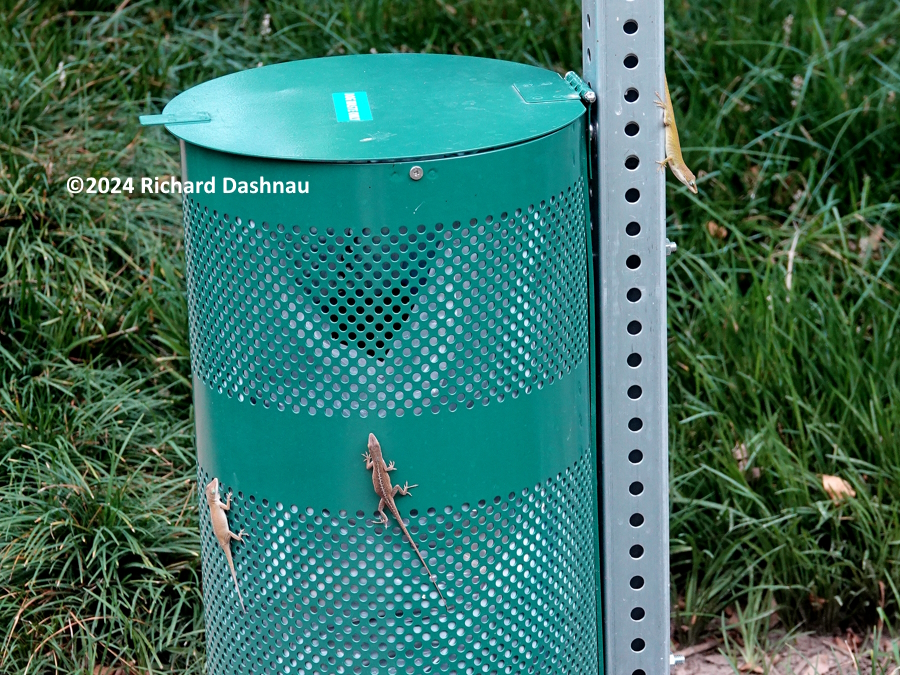
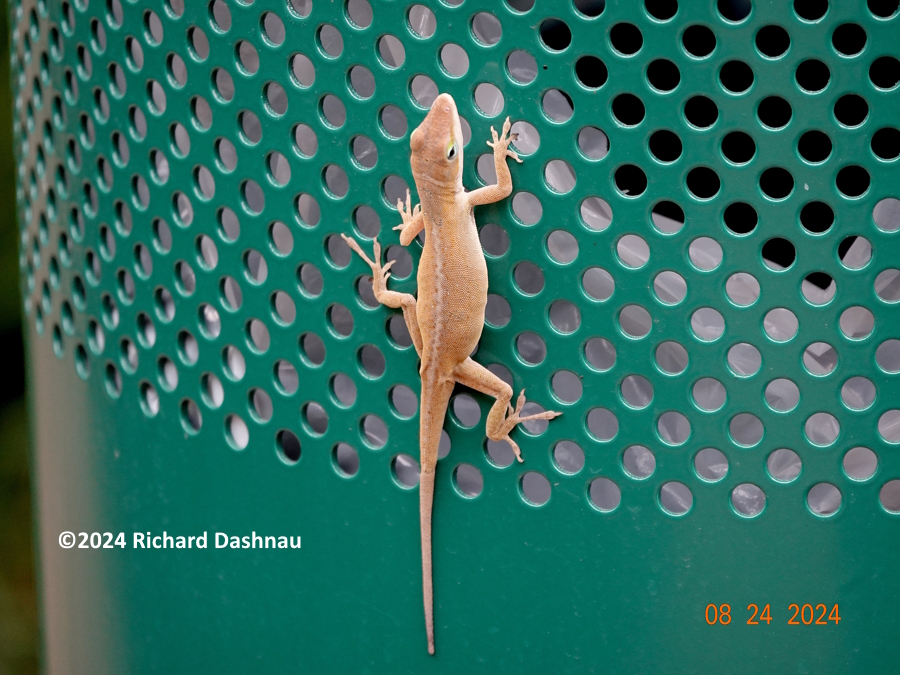
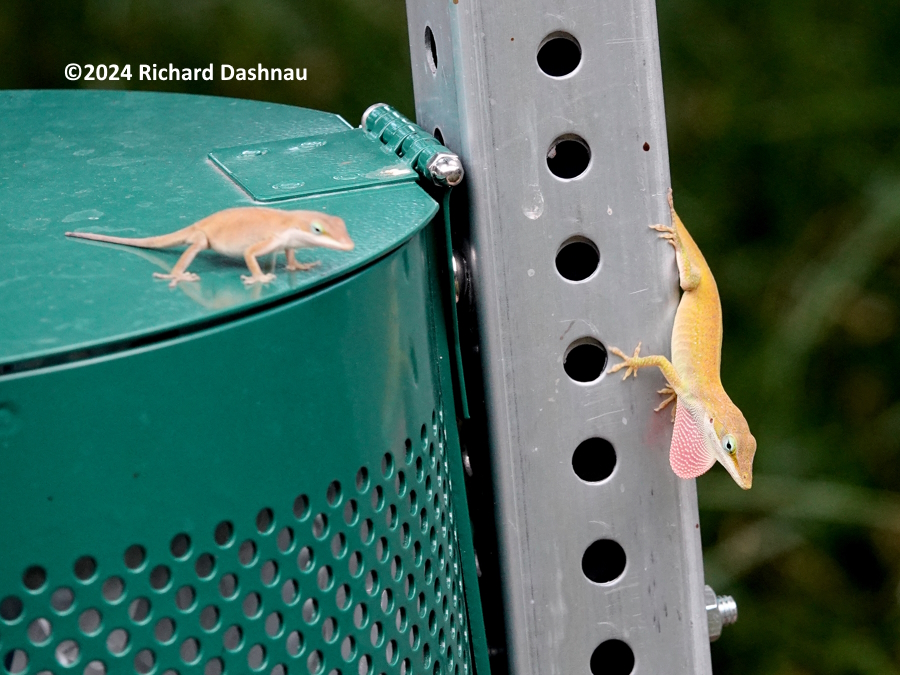
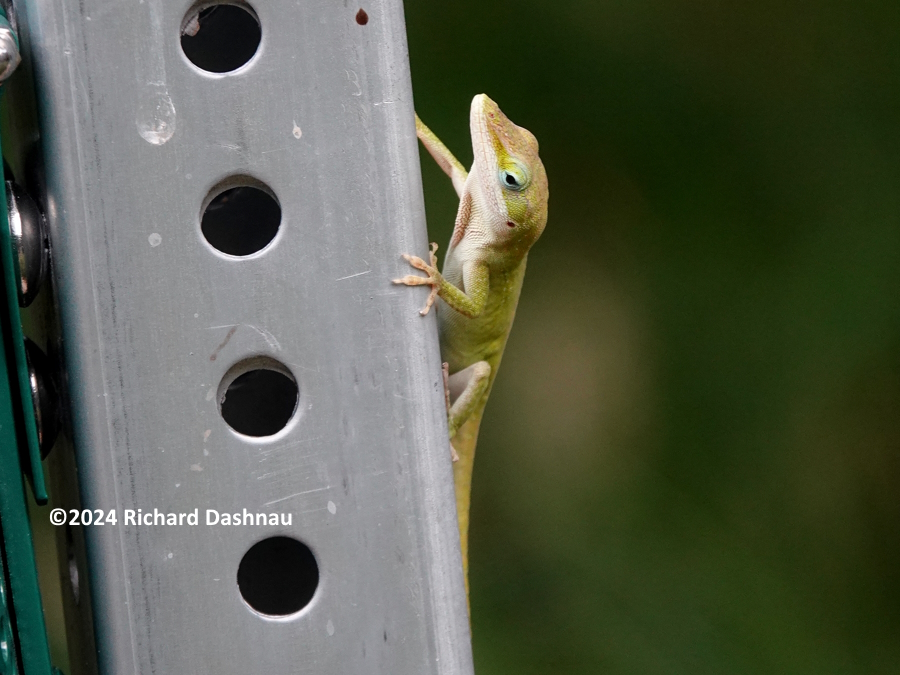
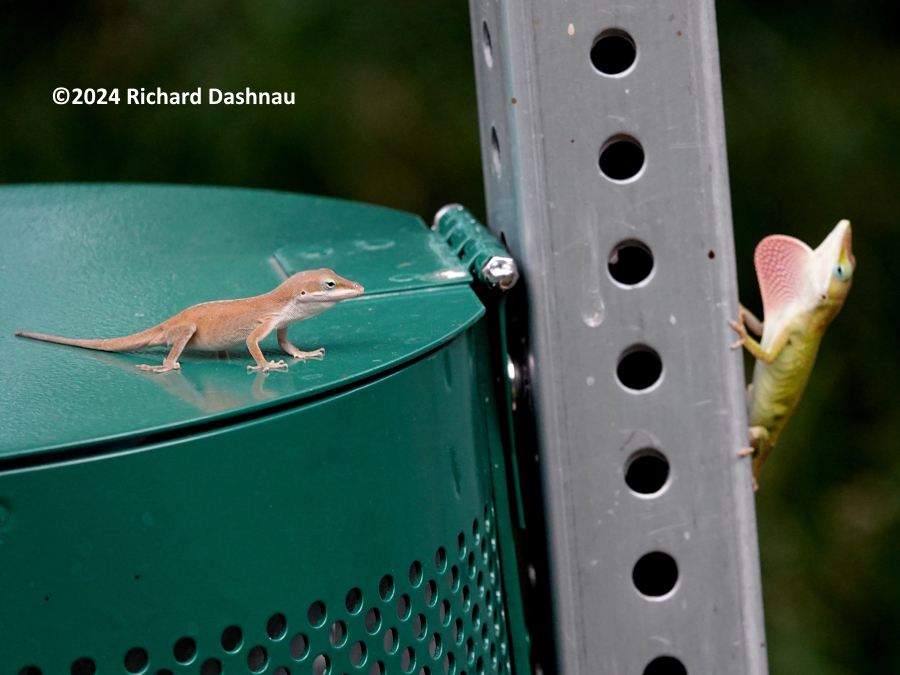
A
male and two
females (as
far as I know)
were hunting.
The male was
larger, with
the larger
head
proportion and
showed its
large dewlap.
The Anoles
didn't lunge
at every
fly, seeming
to weigh their
chances of
success before
trying to
catch one. The
females'
stomachs
seemed to
bulge, and
they may have
been carrying
eggs. I'm
fairly certain
that I've seen
the Brown
Anoles on this
spot, but for
the few days I
paid closer
attention, the
Green Anoles
seemed to
monopolize the
container. The
last 3 images
below
show one of
the Brown
Anoles at the
base of the
tree, near
that
stick--first
on one end,
then on the
other as it
moved closer
to the
container.
But, it never
got closer
while I
was watching.
This study
(Rapid
evolution of a
native species
following
invasion by a
congener"
2014, by
Stuart,
Campbell,
et.al.) shows
that when
Brown Anoles
have been
introduced
into an
environment
originally
inhabited by
Green Anoles,
the Green
Anoles move to
higher parts
of the
habitat, and
also physically
change so
their toe pads
are
larger and
contain more
setae
(very tiny
hairs that
enable
adhesion); or
as the study
says "larger
toepads with
more lamellae
(adhesive,
setae-laden,
subdigital
scales)". This
change took
about 5 years
(or "20
generations",
in the
study).
The video
clips show
better views
of the Green
Anoles' toe
pads in
action. This
could be an
example of how
the
Green Anoles'
more efficient
climbing gear
allowed them
to take better
advantage of
this food
source than
the Brown
Anoles could.
I have better
views Anoles'
toe pads
in action on
my page here--Lizards,
Page 1.
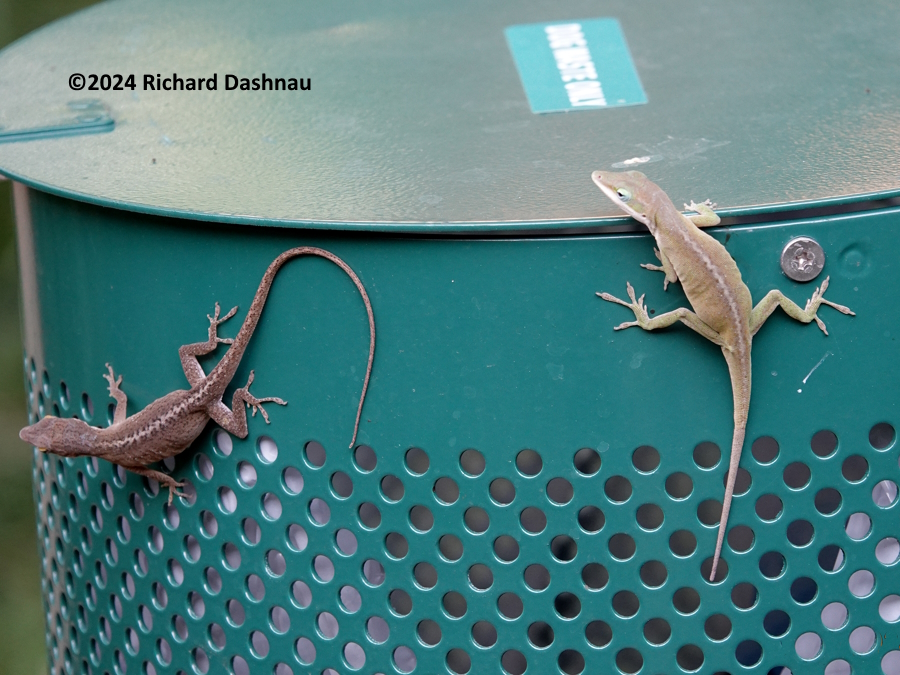
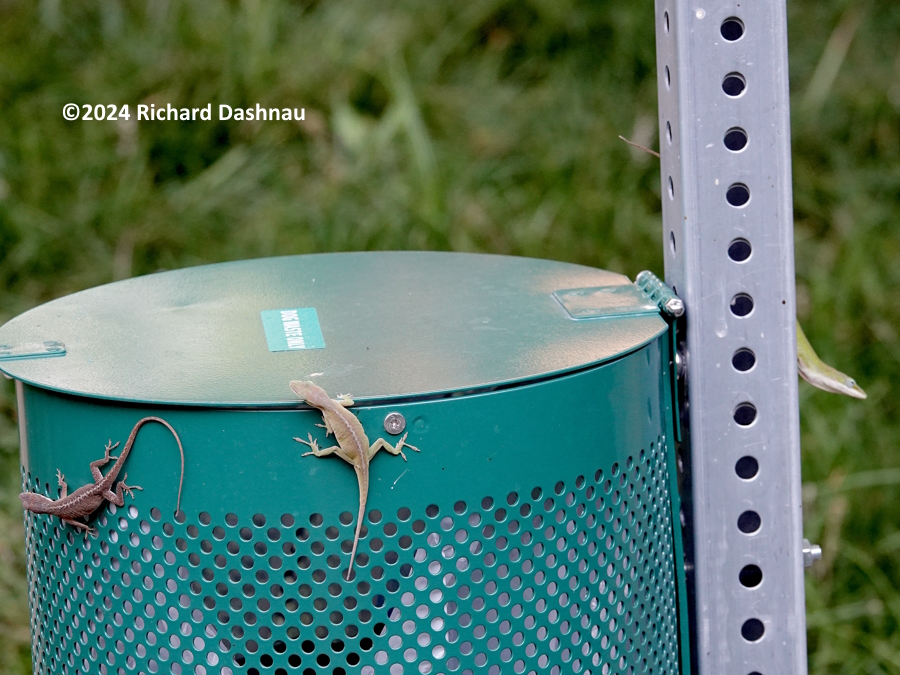
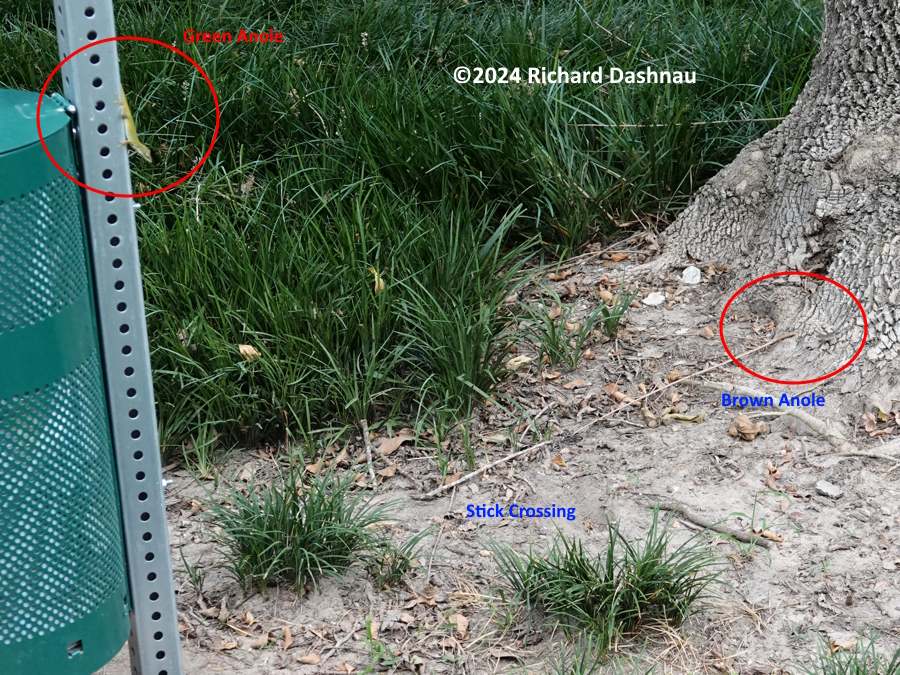
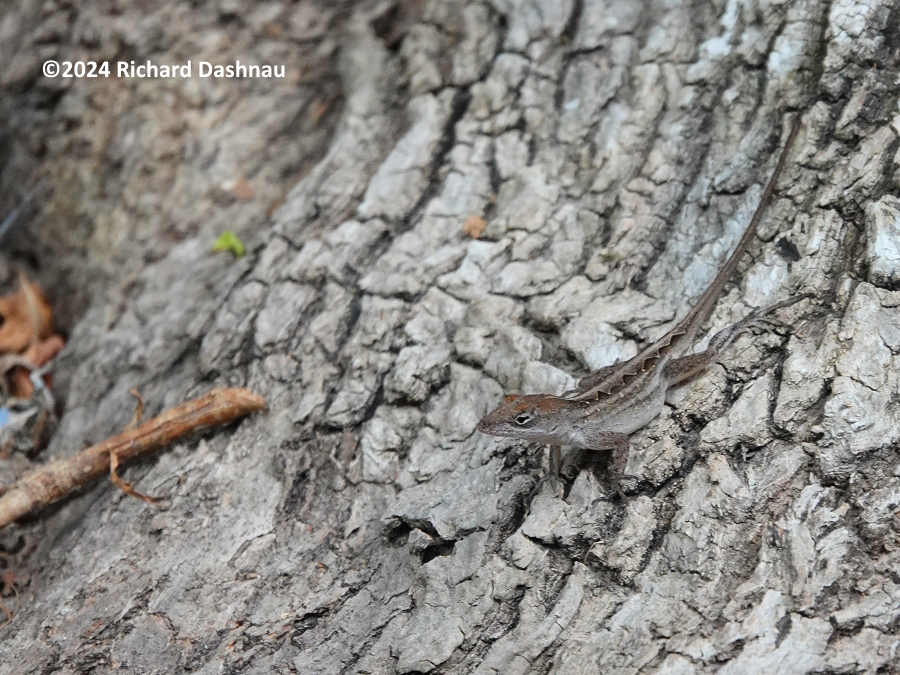
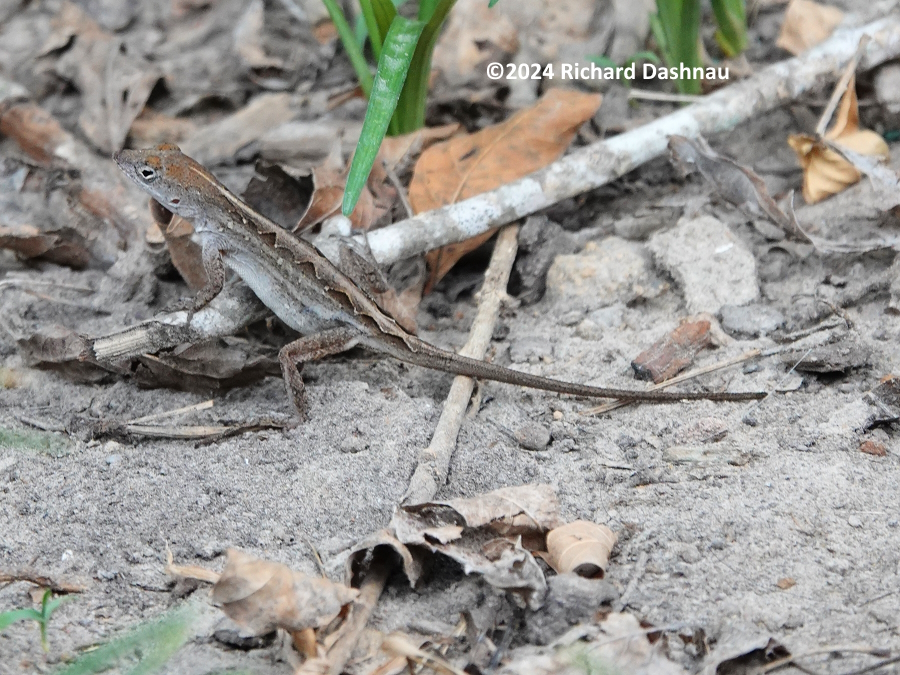
From Russ Pitman Discovery
Center on 07/23/2022
I had some time to walk around the "park" at Russ Pitman
Discovery Center this morning. Anoles have
been relatively scarce since the infamous Texas Freeze of
February 2021 (especially in my neighborhood). Since then,
I've been able to find at least a few Anoles at Russ Pitman.
There have been a few more Anoles in my neighborhood, both A.
Carolinenis and A. Sagrei (but ONLY a few, compared to
the dozens I used to see before the freeze).
On this morning I saw a few lizards scurrying around, but then
I noticed this one on a tree-captured by beams of sunlight
that made it through the leaf cover. I tried to catch the view
as
I experienced it-and these photos turned out best. I feel that
it was important that I don't enhance or manipulate the images
much--because the sunlight was bright enough to shine through
the lizard! Its tail and legs seemed to glow red--and when it
extended its dewlap; that was radiant, too! Light even
appeared in the ear openings! These images were the best I
could get
before the moment had passed.
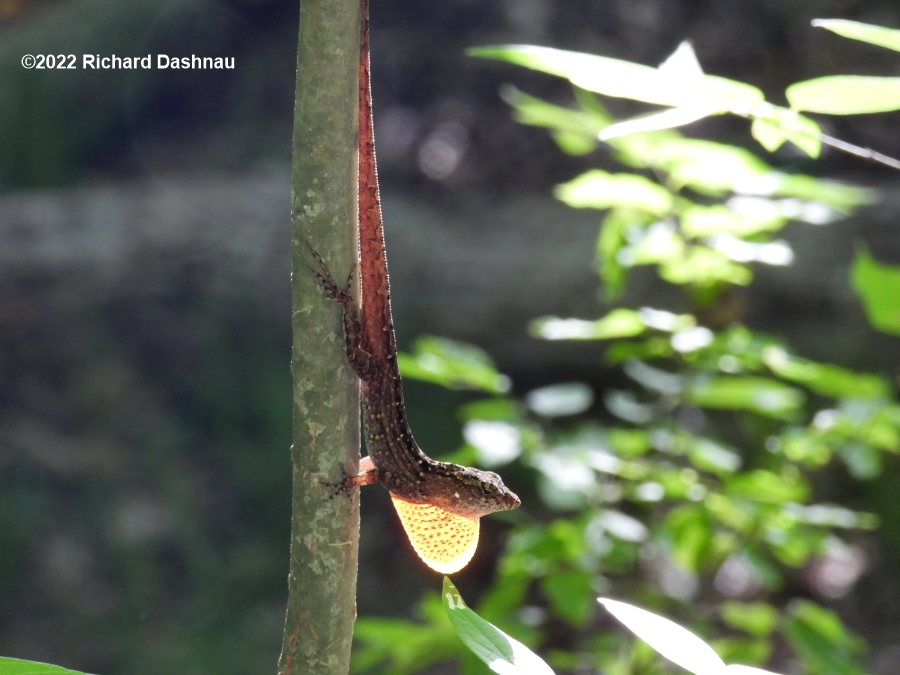
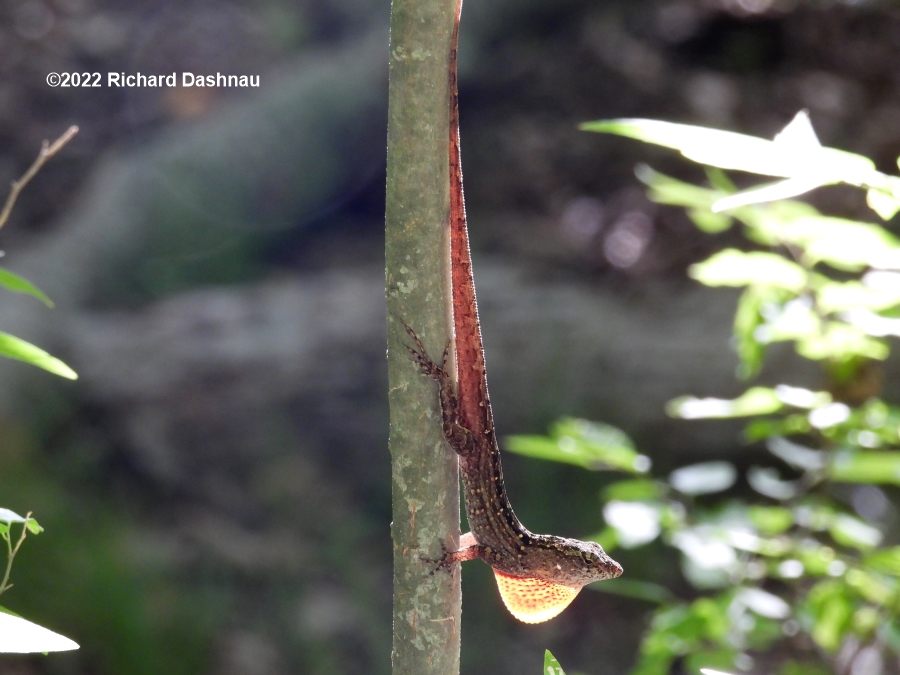
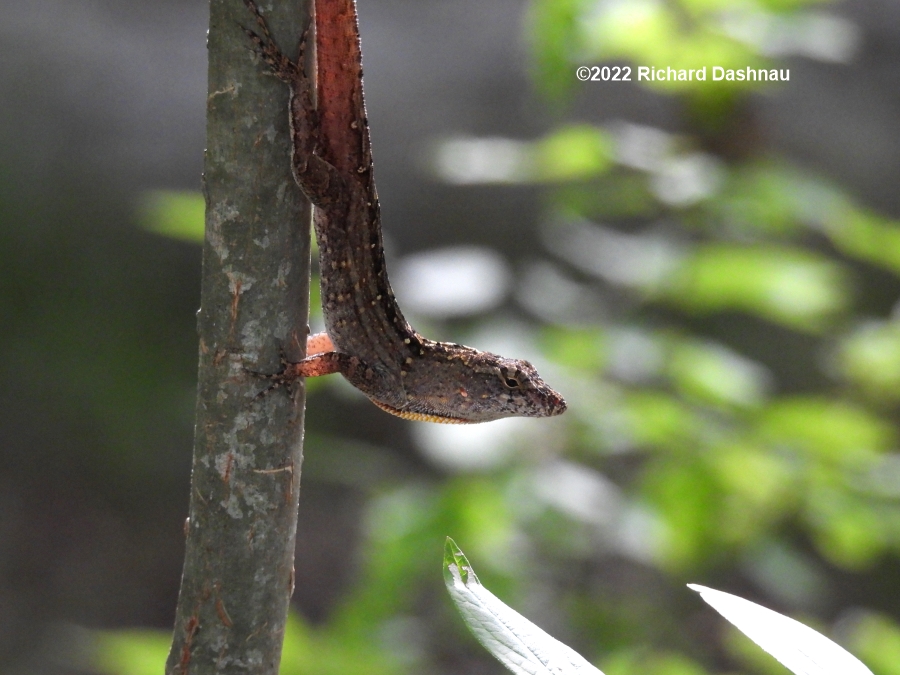
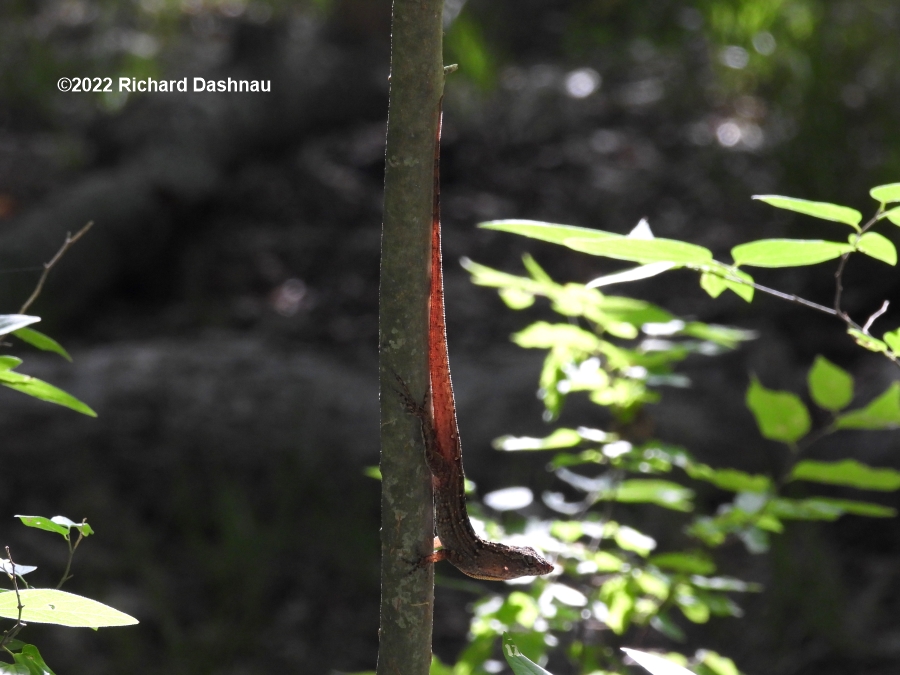
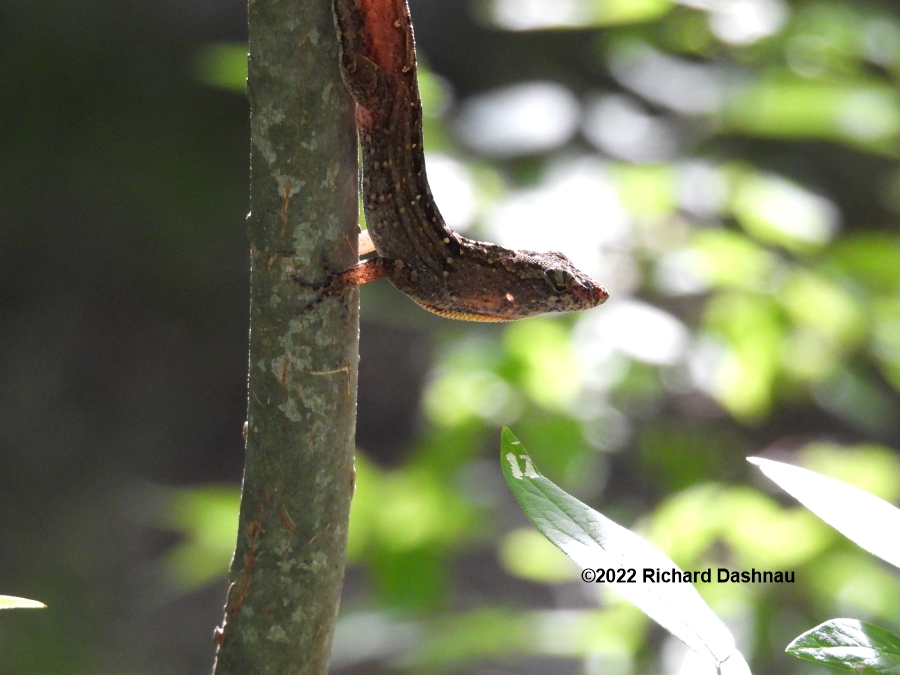
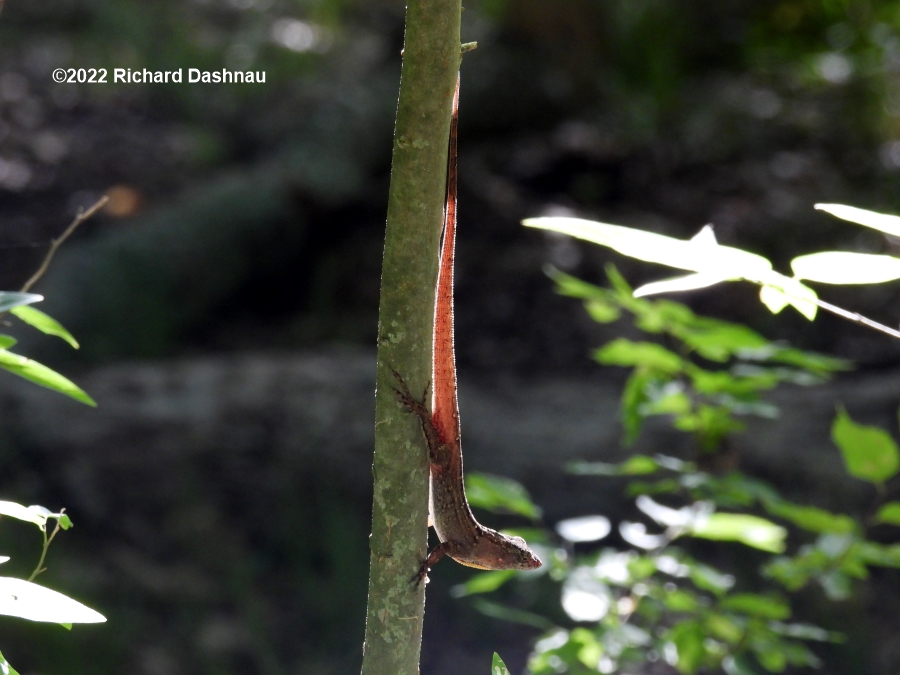
05/06/2021 I
went back to Russ Pitman Park to try to see a female Eastern Screech in
one of the nest boxes there. I was lucky! She was in the box, with
her head
filling the hole. Her mate, the male, was in the same tree as
before. While
I was there, I also looked for lizards. I didn't see very many
this time, but here are a few Brown Anoles
(Anolis sagrei) that were out.
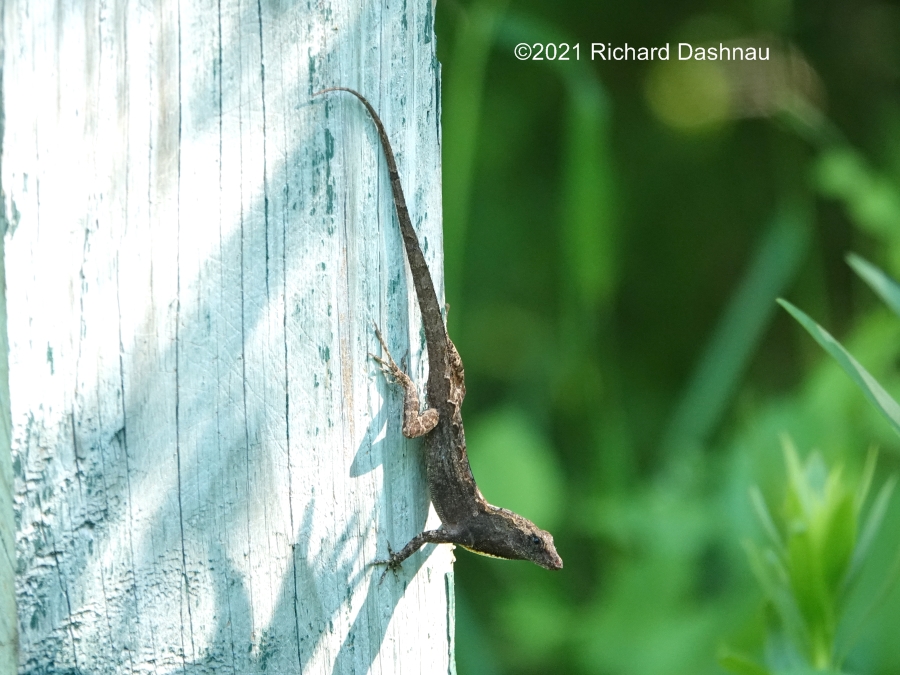
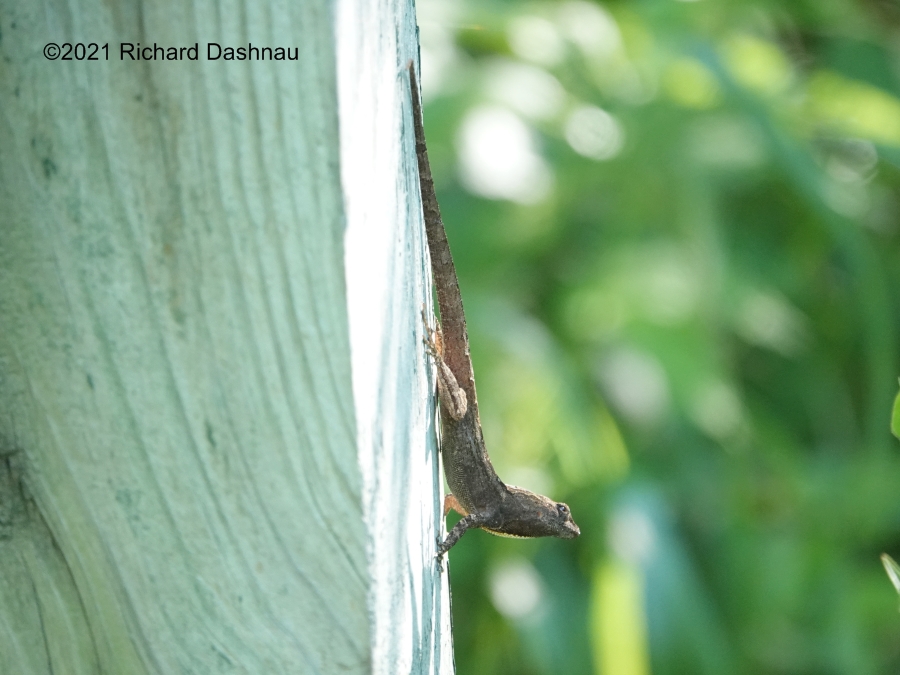
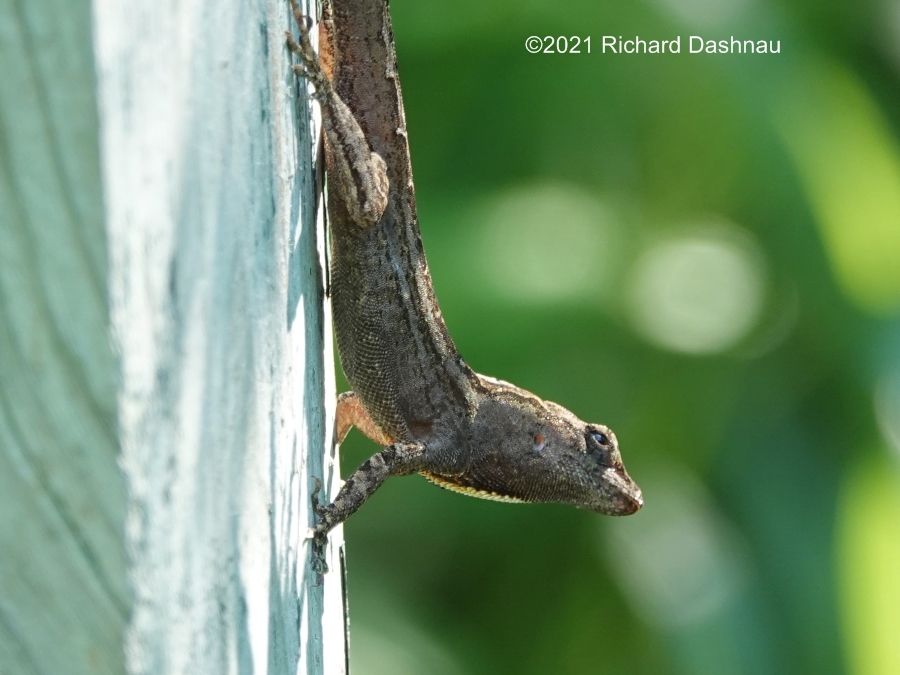
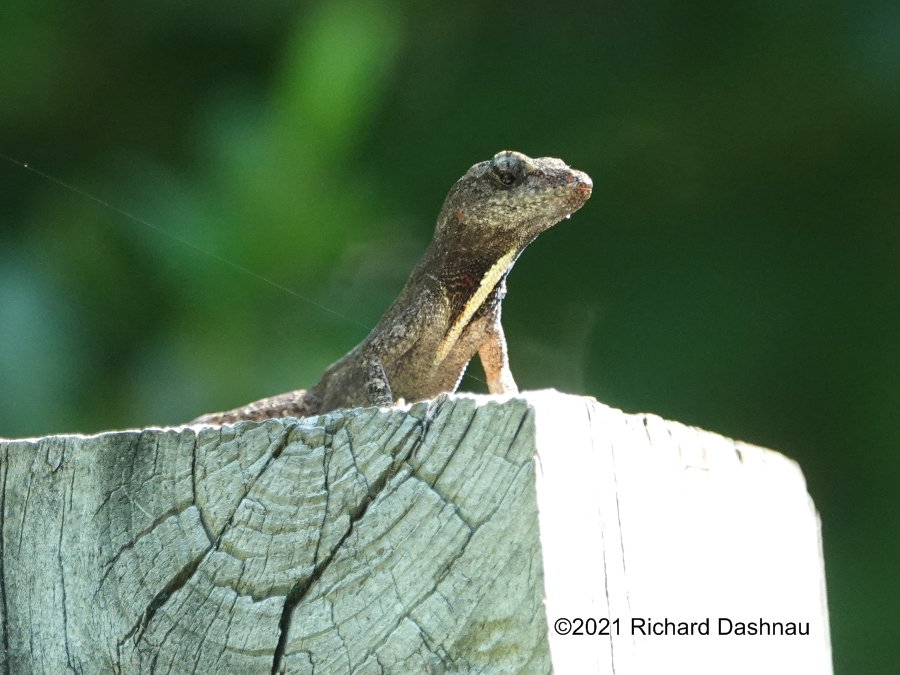
04/20/2021 I've
noticed
that there are no lizards in my neighborhood. I have been looking for
them since we had that hard freeze event. I expected to see them
at least with the return of the
warmer Spring weather. But...I haven't seen ANY.
Many of the plants in my neighborhood were killed by the cold.
Walls that had been covered by creepers and ivy are bare now. I
believe
that if the cold reached in deeply enough to kill all that cover, then
the lizards hiding in it have also died. Some of the entries on my
lizard page show many images of anoles (mostly Brown
Anoles) that I saw here. Now, I don't see any while I'm walking my
dog, or at any other time. Today, I went to Russ Pitman Park to
see if I could find any Anoles there. is
a
very small (4 acres)
park in Bellaire, Texas. Even though it is small, it is
filled with wildlife! And, I saw some Anoles there--so I know
that some have survived somewhere. Here are some Brown Anoles
(Anolis sagrei)!
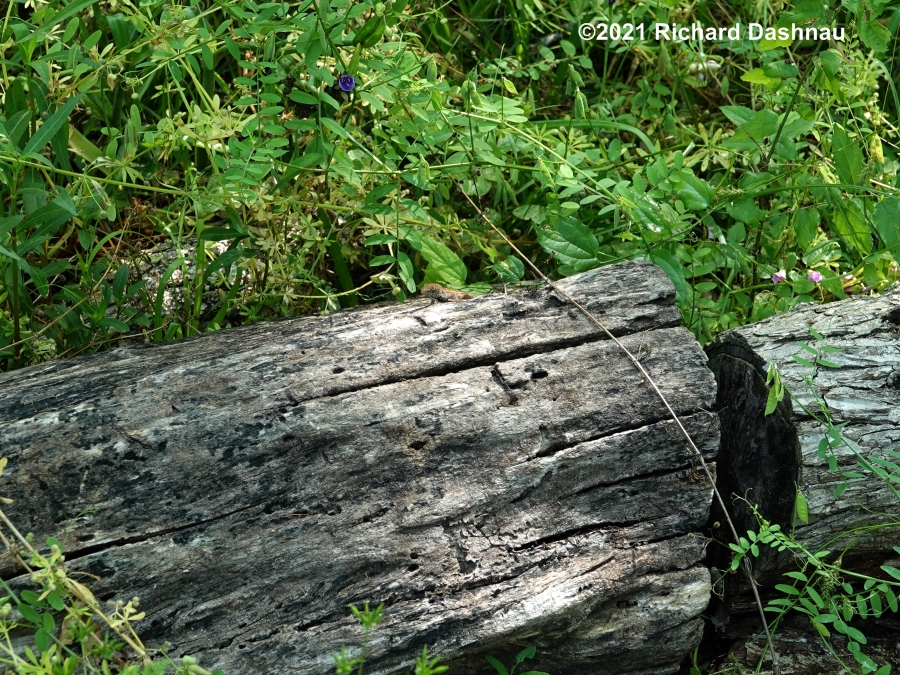
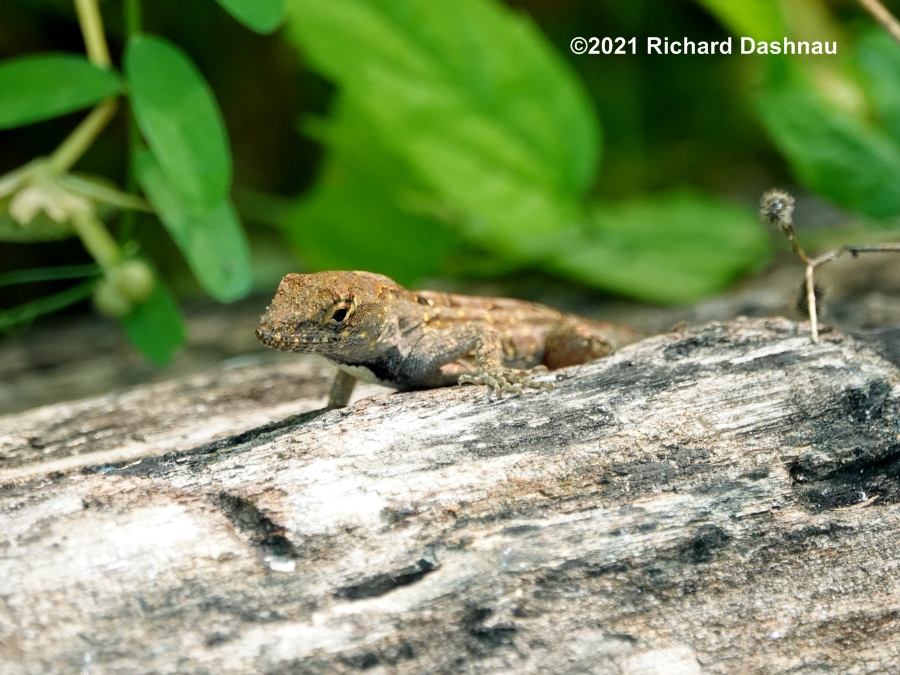
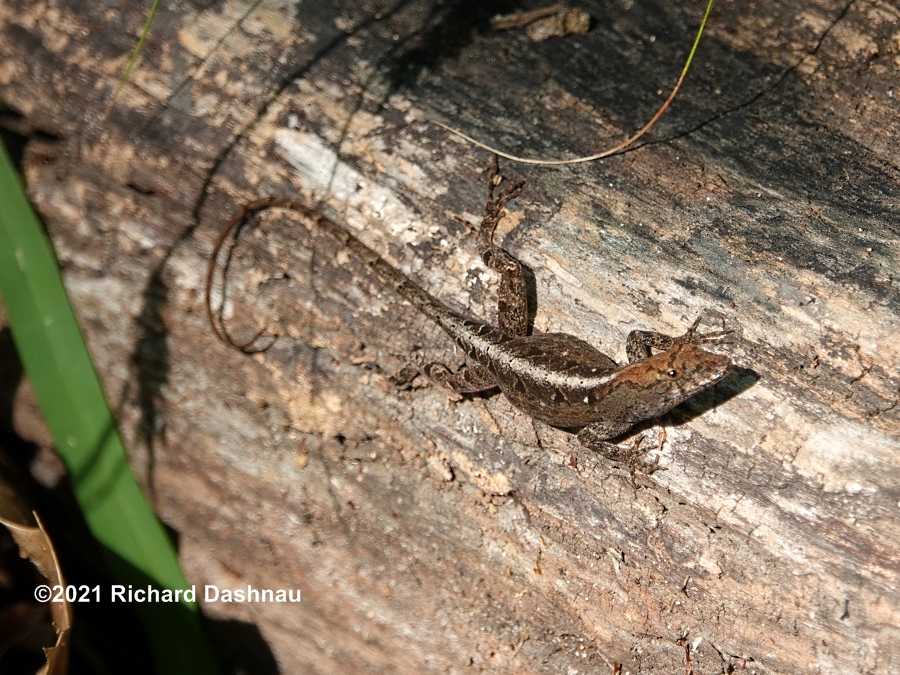
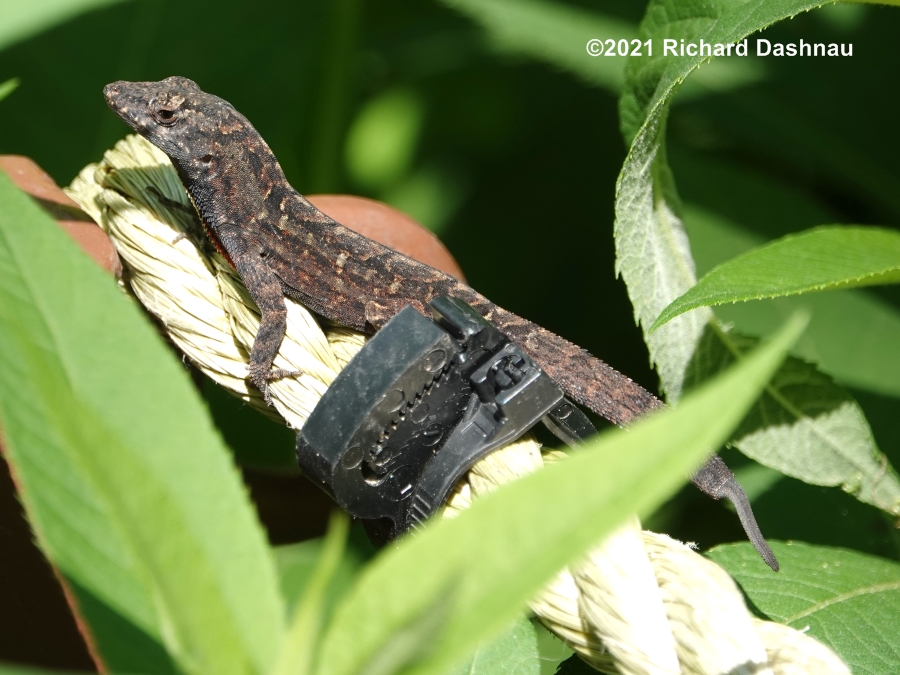
One
on that log.
There's the one
on the log, closer.
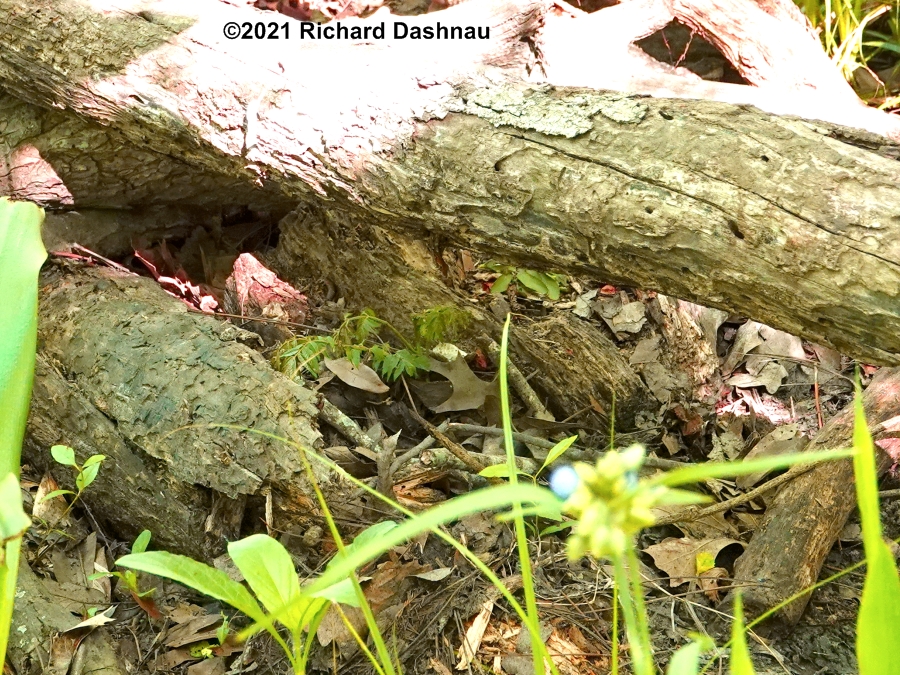
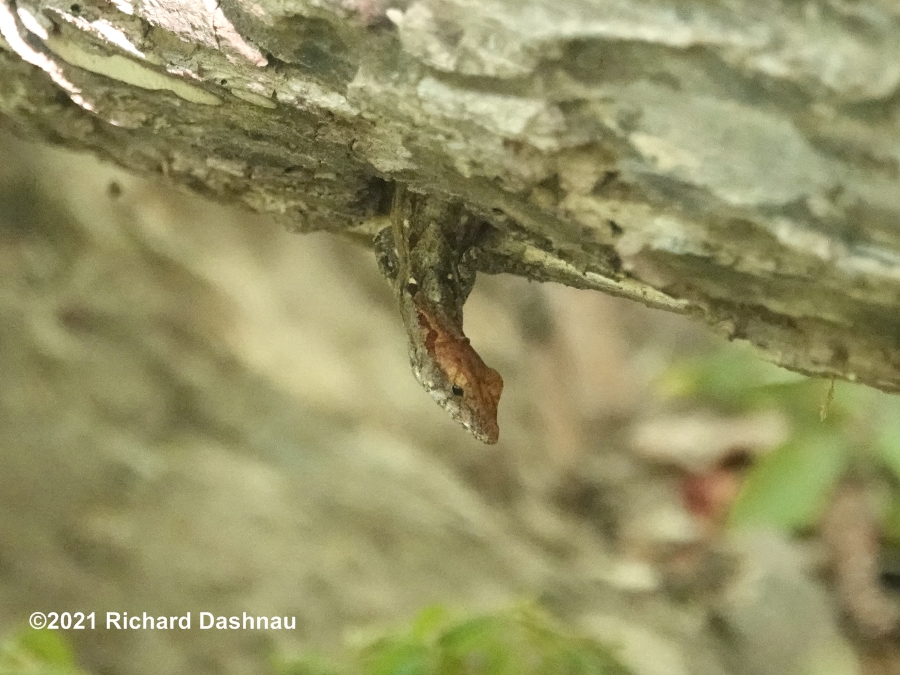
One
under that log.
There's the one
under the log, closer.
I also found some Green Anoles!
(Anolis carolinensis)
Here they are!
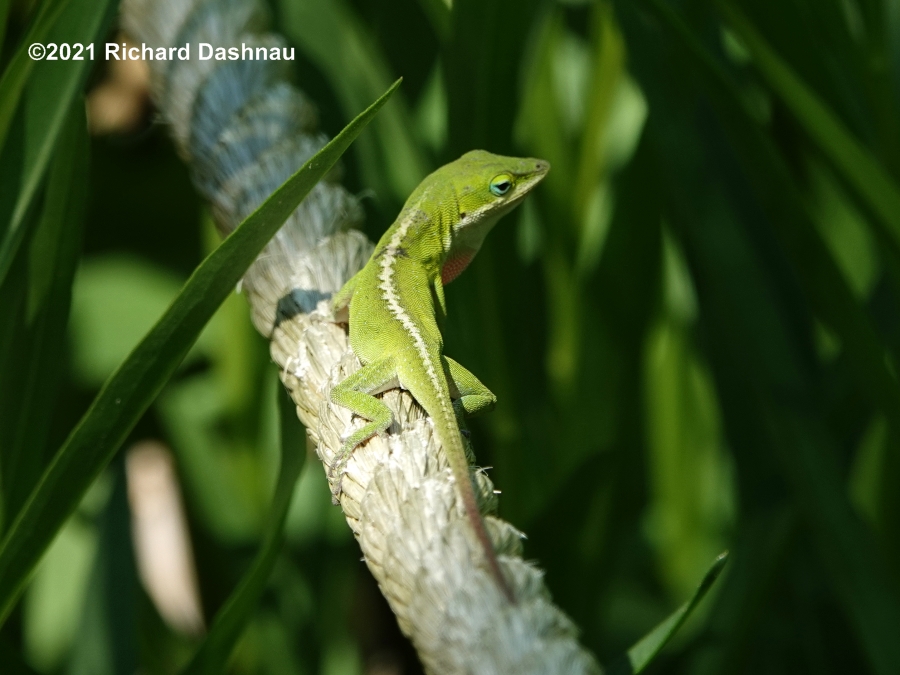
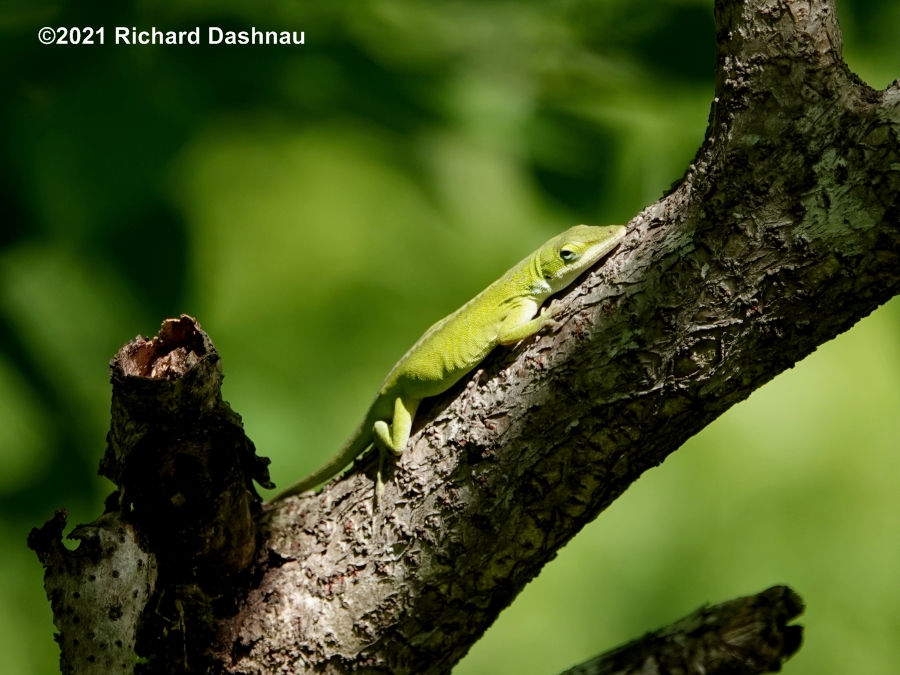
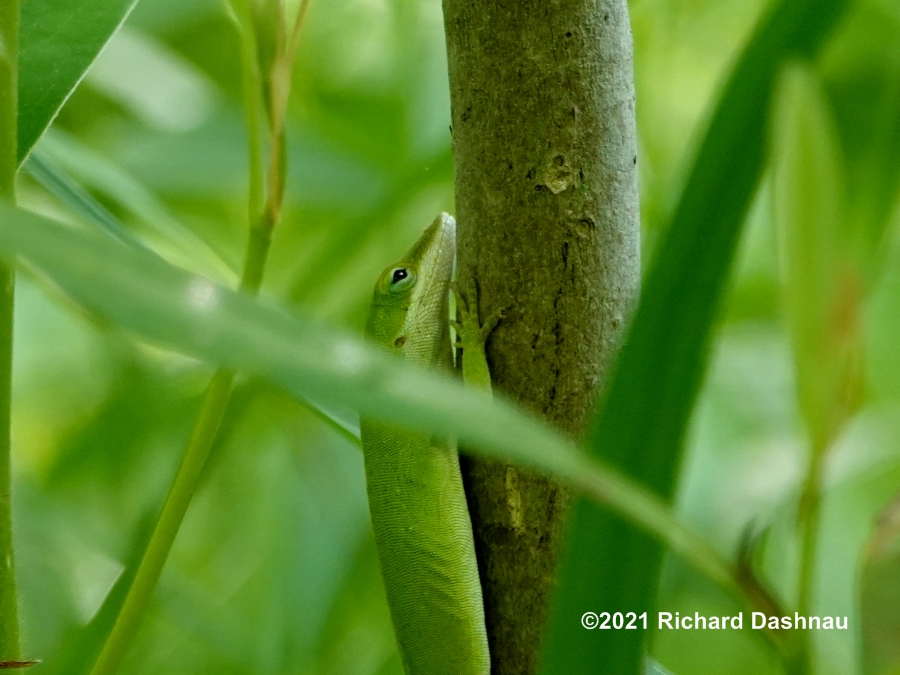
June
24 2020 (update 08/05/2020)
Like
almost everyone these days, I've been staying inside. I
have stopped driving around outside
for...recreational purposes. Even though I've been
trying to update older material in my domain; I have taken a few
pictures around the neighborhood. So...here we go, from a couple
months ago. Brown
Anoles (anolis sagrei) have overrun
the vicinity. This means that on most pleasant days, I can see
them everywhere.
I'll pass 6 or more just by walking to the parking lot. I
noticed this one because it had entered the color
phase (that's what I call it) where the body is dark, overlayed
with patterns of yellow (or white) spots (as opposed to lines or
diamond patterns). Caught in by the sun, this male was
beautiful!
Judge from the pictures below, if you will. I always
try to capture high-speed video of anoles jumping or
climbing--but don't succeed very often. I shot video of this one
showing his dewlap,
and then after he moved to another stone, he leapt towards
me. I was actually about 8 feet away and shooting by
zooming in-so he wasn't actually leaping at me.
I captured his leap, although
he leapt from clarity to blur. I've edited the two clips
together into this video clip.
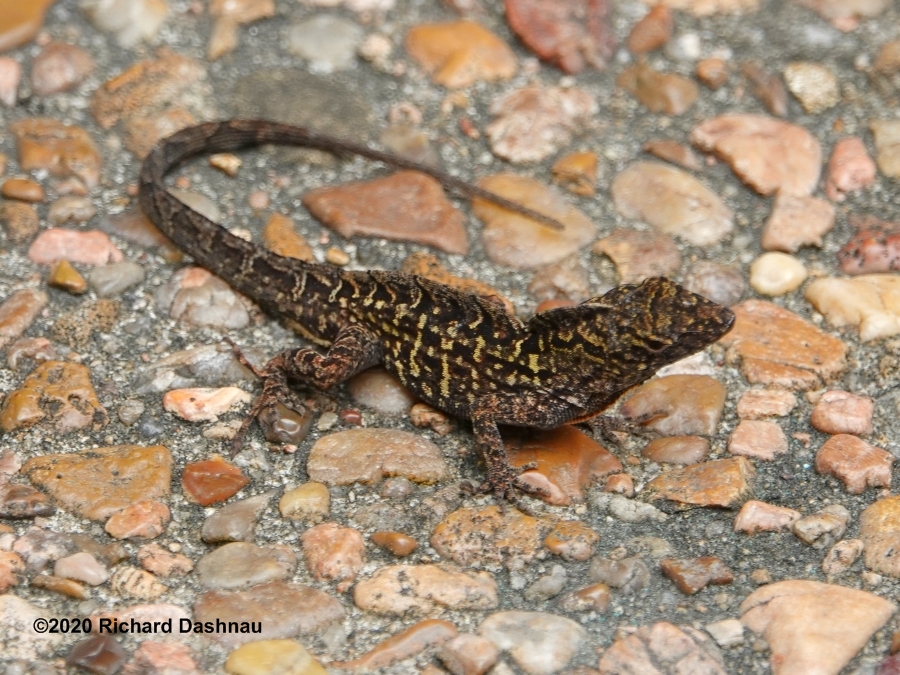
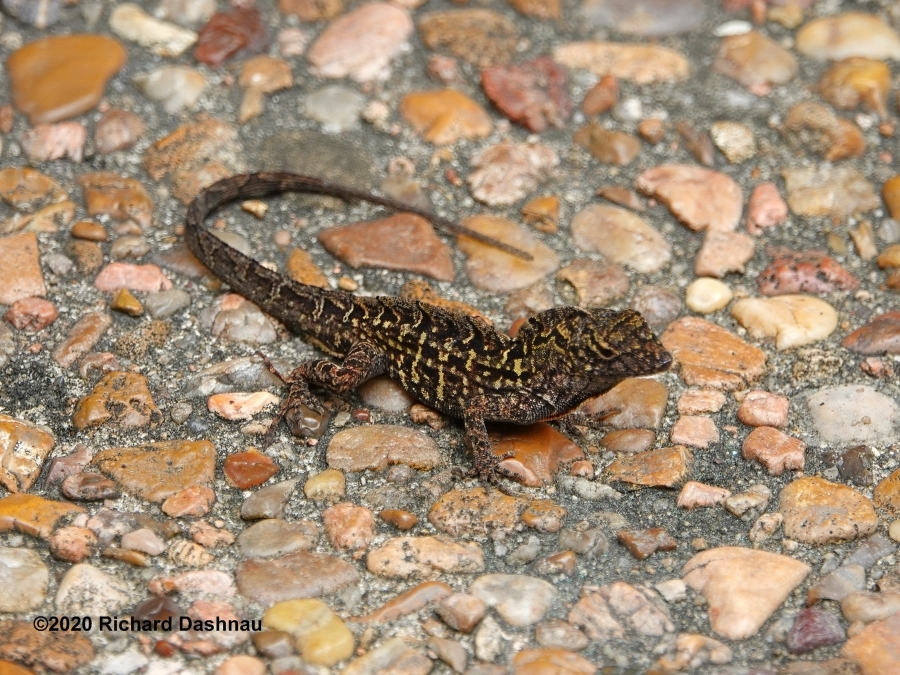
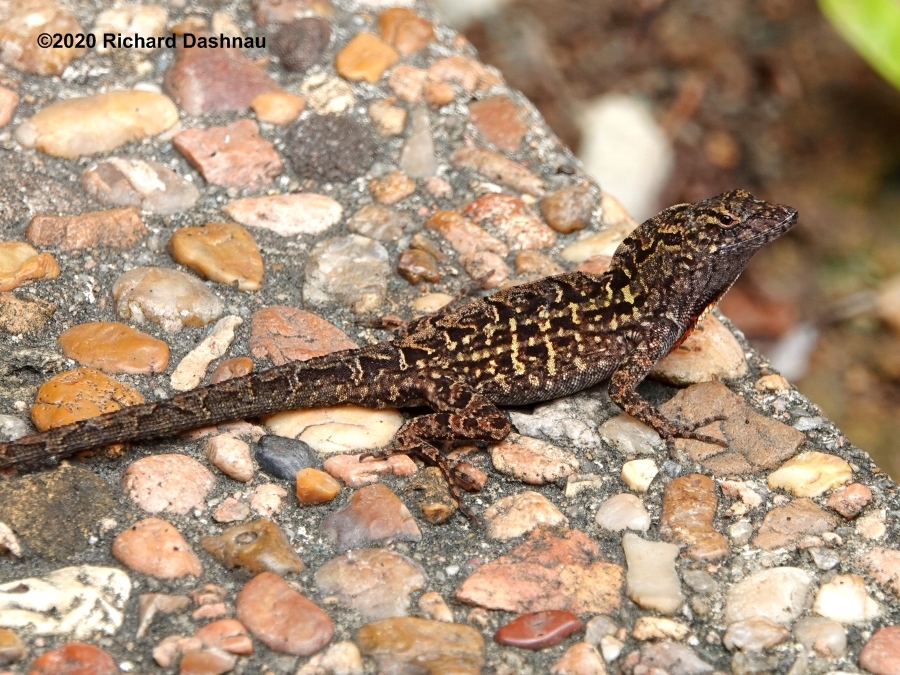
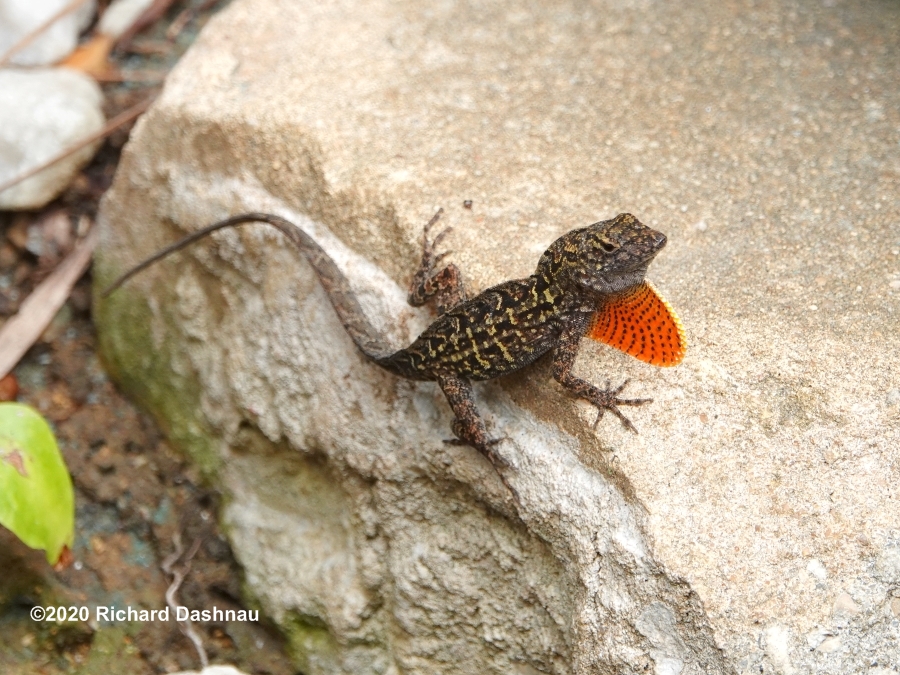
04/23/2020 Like
almost everyone these days, I've been staying inside. I
have stopped driving around outside
for...recreational purposes. BBSP is just too far away, AND,
entrance protocol
to the park has changed dramatically (even for volunteers).
So...I haven't been going there. The parks in the city are
generally pretty crowded (when they are open) so I've been
staying away
from them, too. Still, it is possible to have a quiet walk
anyway. Today, I walked around my neighborhood with a
camera. I was looking for anoles (and whatever else I
could find.) Here's
what I found:
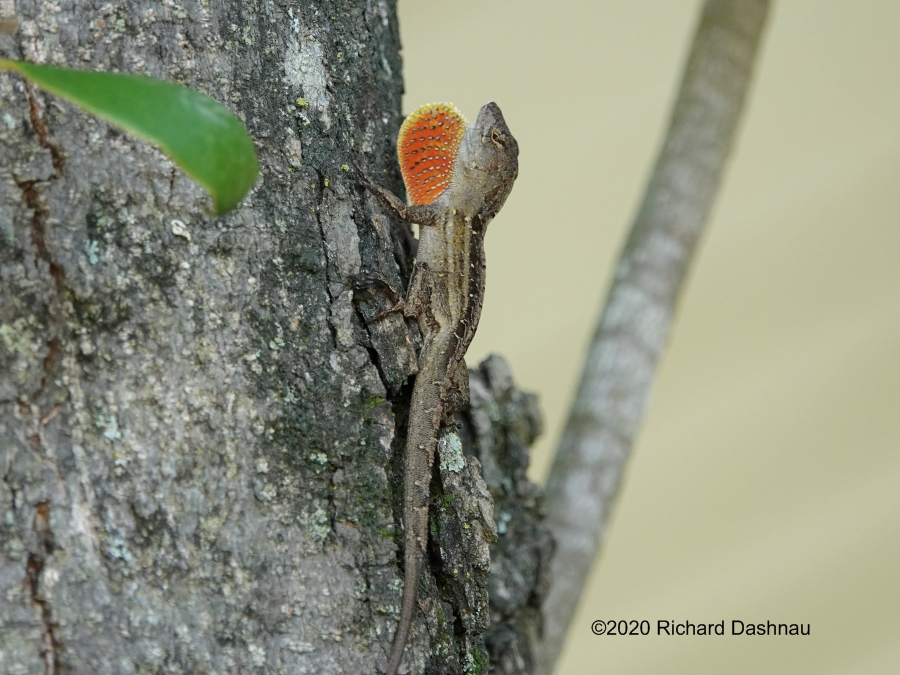
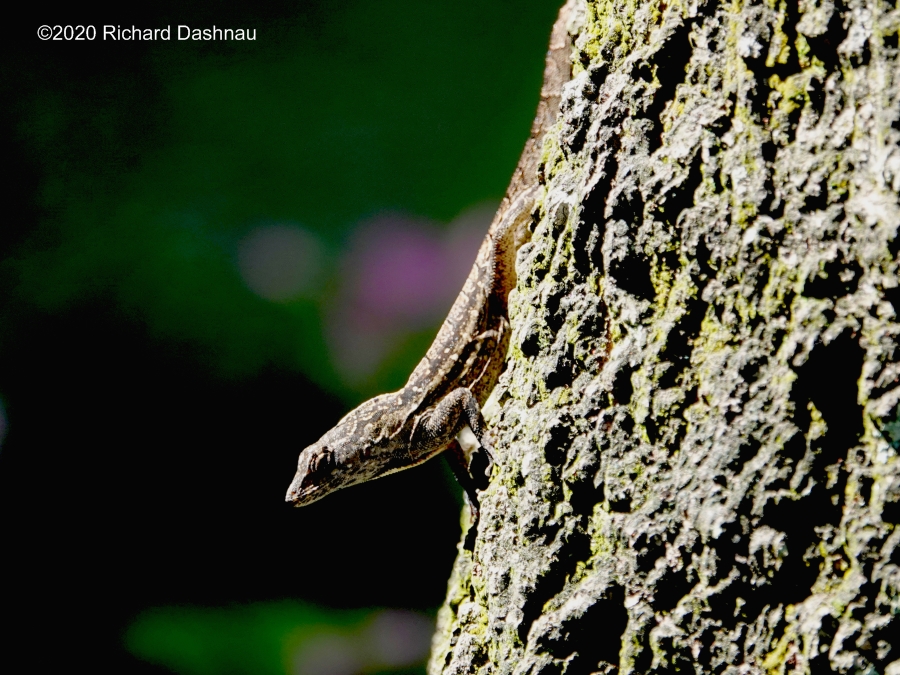
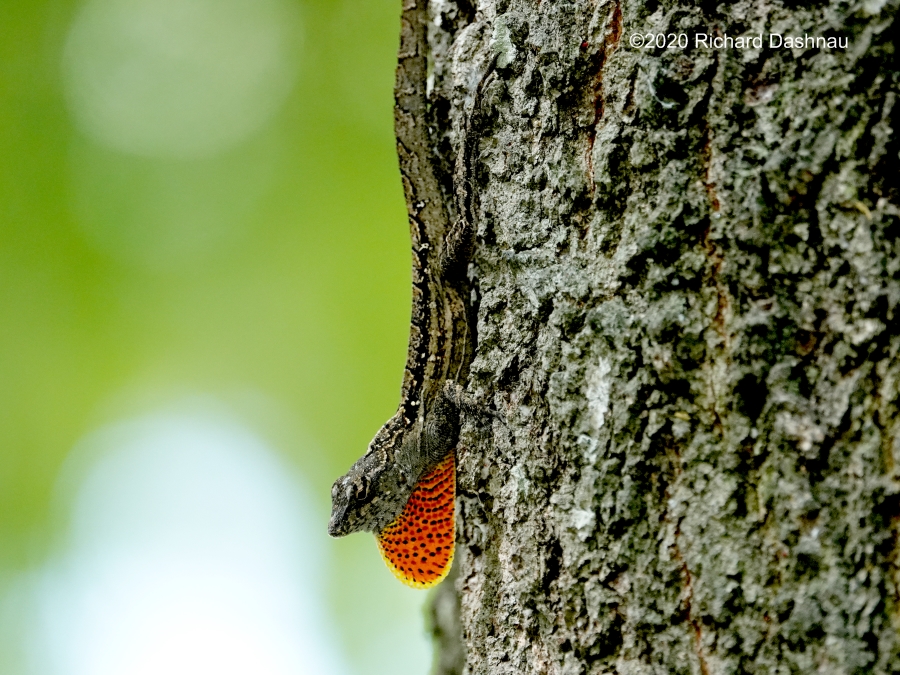
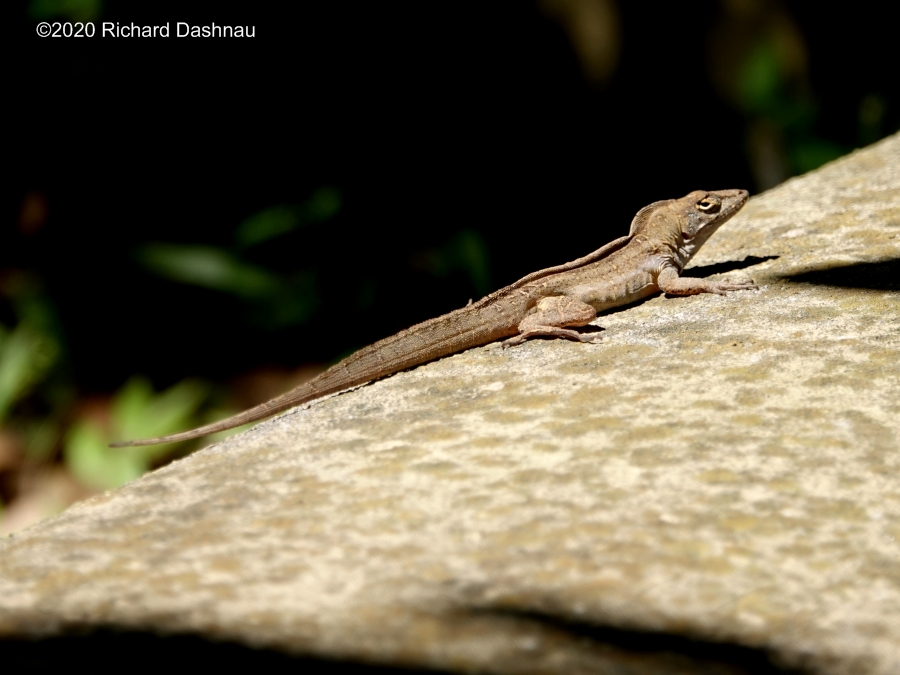
The
bright
orange dewlap with yellow border helps identify these as
Brown Anoles. They often cling head-down on trees and other
supports. Look at the gorgeous crest on this one!
Brown Anoles (Anolis
sagrei) don't turn from brown to green (and back again) like
native American Anoles (Anolis carolinensis). But they can
change color somewhat.
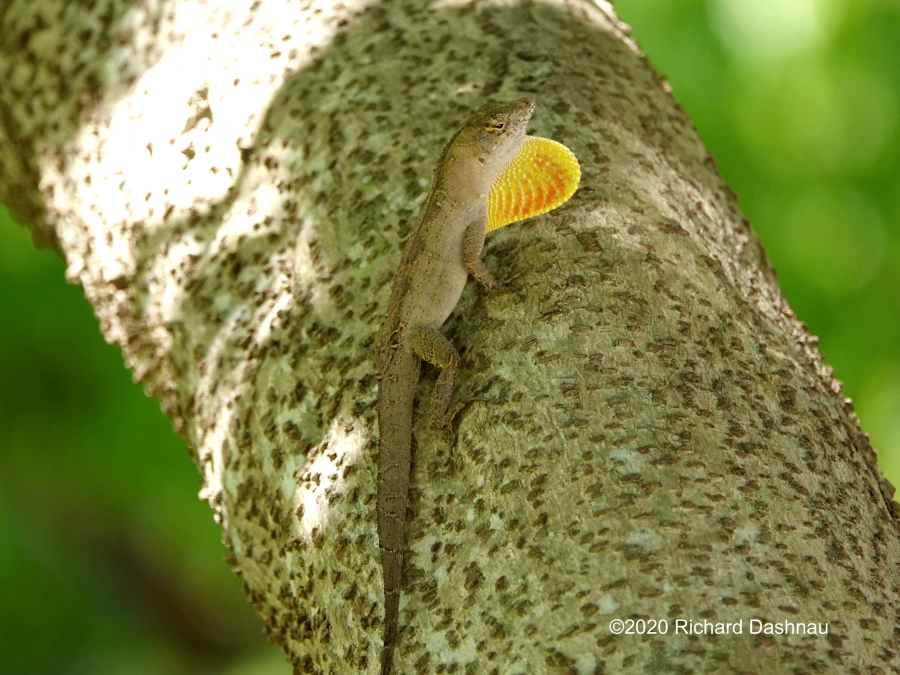
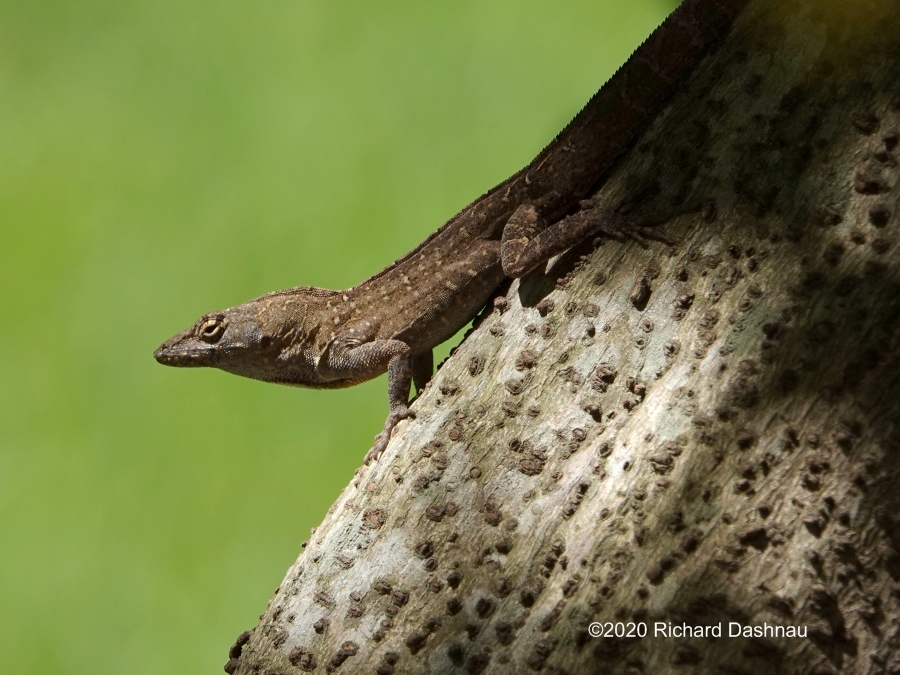
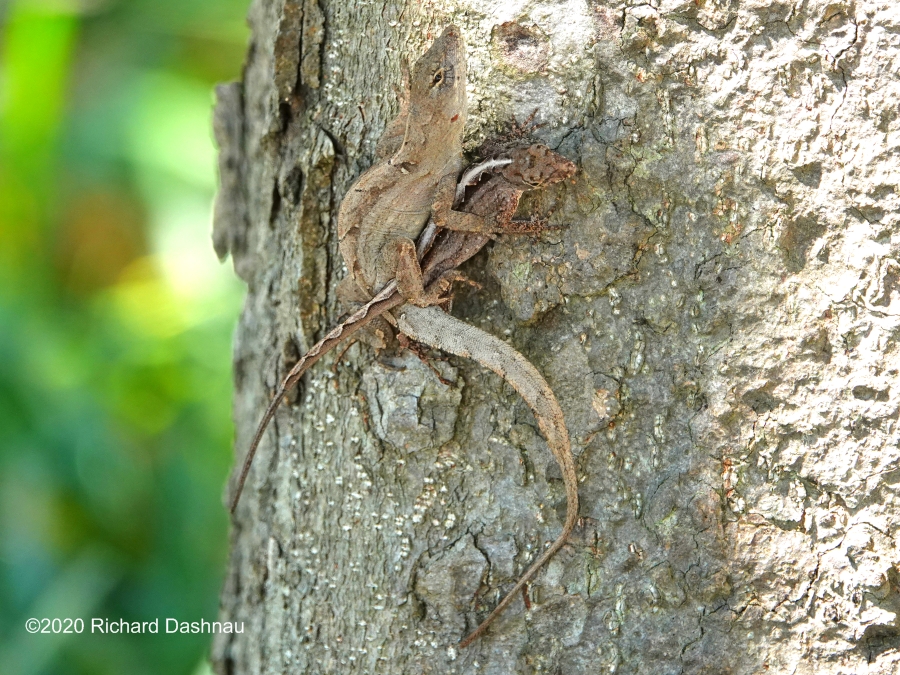
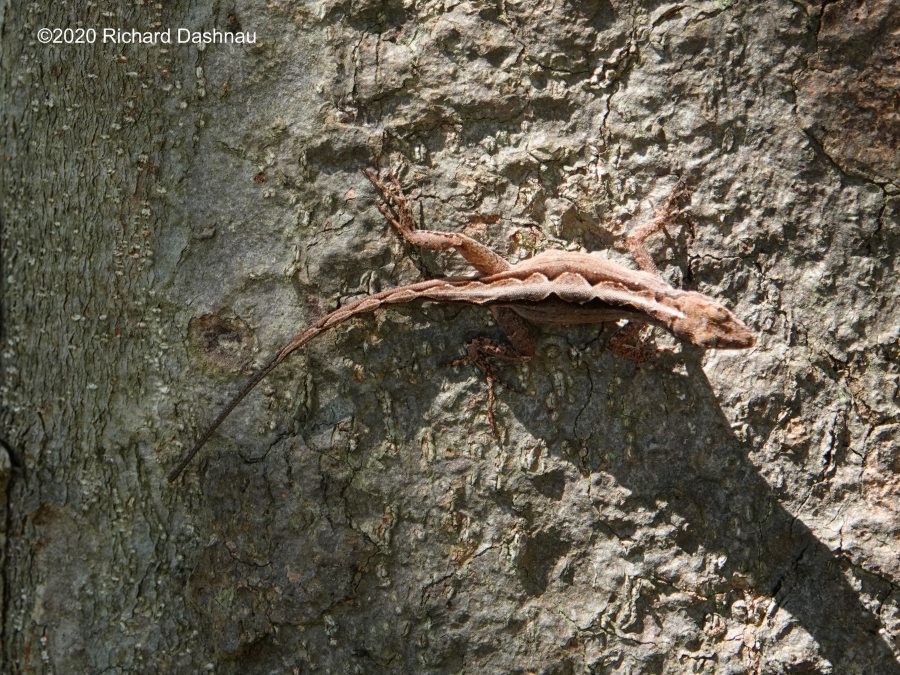
Brown
Anoles
have distinct patterns, but the patterns seem to be
variable. I found two of the Anoles trying to start
making little anoles. This is the female after
they...finished.
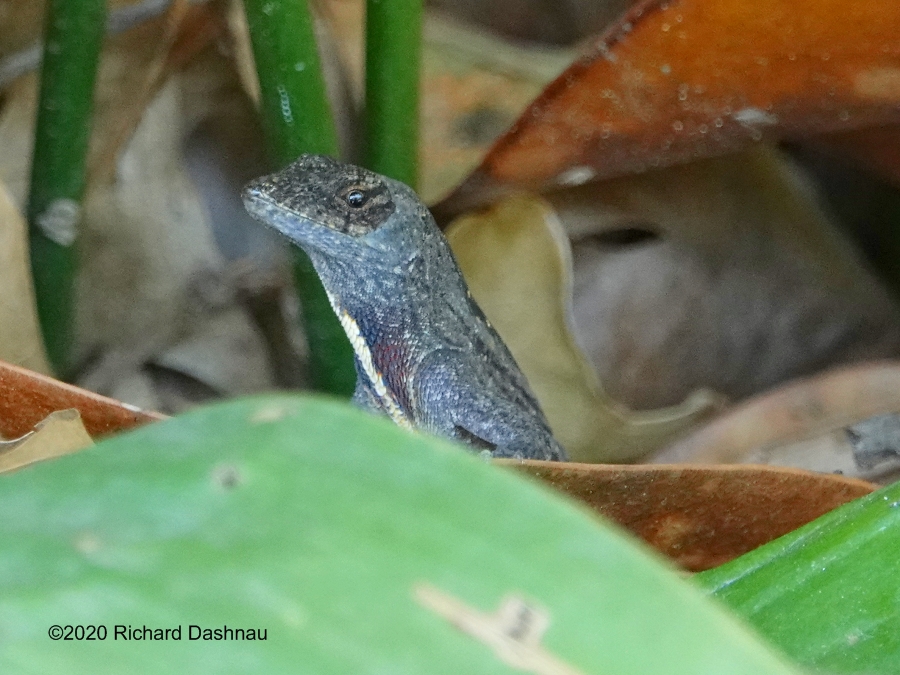
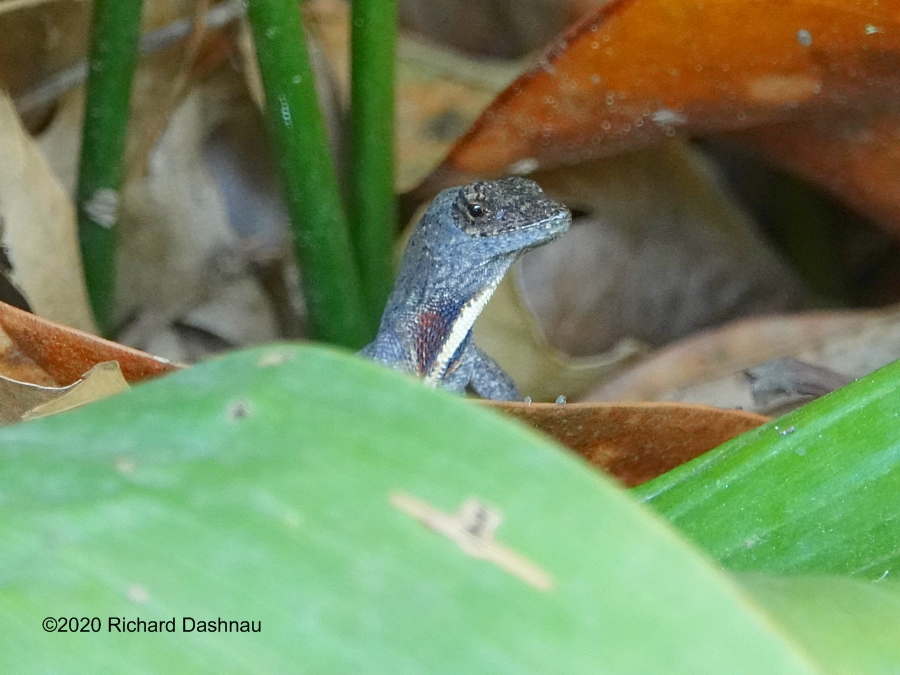
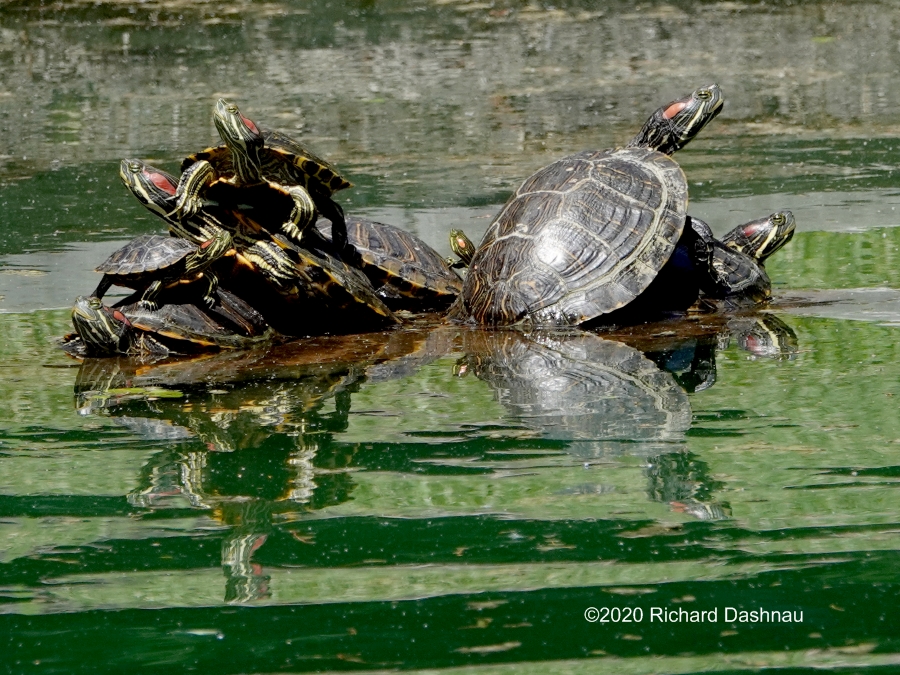
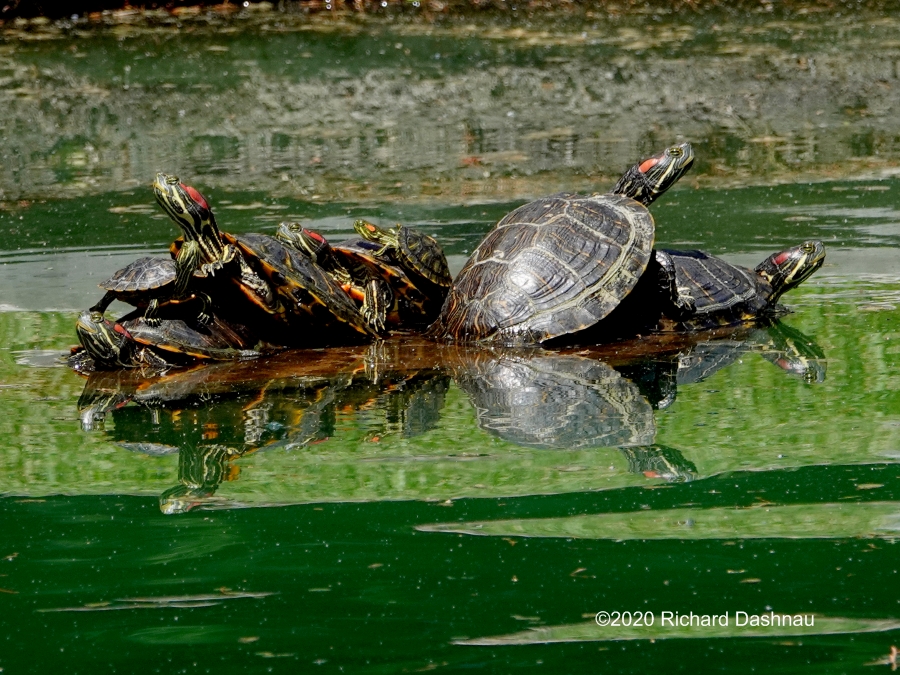
I
found this one under some plants. Unfortunately it ran off when
some people walked by. These turtles were in a
decorative "fountain". Turtles! All the way down! HA ha
ha!
I didn't notice the odd (bluish?) color until I looked at the
photos. I was in bright
These all appear to be Red-eared Sliders
(Chrysemis scripta).
sunlight at the time, I think the odd skin color
represents "dead" skin the the anole
has started shedding. It almost appears to be...wearing a face
mask. (!!)
08/12/2019 While
at
Russ Pitman Park, I was able to film a Green Anole (Anolis
Carolinensis). They are difficult to find. Some of
the information I've read shows that the introduced Brown
Anoles (or Cuban Anoles (Anolis Sagrei) are displacing our
native species. The native Green Anoles may adapting to
this pressure by changing their preferred habitat to a higher
elevation.
They are moving to the higher branches of trees and plants.
Hopefully, there is enough food to support them up there. Along
with this apparent move, their bodies seem to be adapting.
At
least one study shows that anoles that are living higher have
more clinging hairs (called setae) on their toes than they used
to. Setae are very tiny hairlike structures with the free
end flattened.
These are small enough to stick to objects by molecular
attraction (Van der Waals force). A single seta doesn't
generate very much force. But, anoles have thousands on their
toes--and
these generate enough force to allow the lizards to cling to
various surfaces. Since anoles can't
turn
off this attraction, they have to peel their toes off
of surfaces. That is, they pull the hairs
off in small portions. Their toes curl up as they lift
them. This
video is a demonstration of this toe curling for release,
and straightening to cling. I filmed it at 480 fps, and it
playing 16X slower.
The image below is a screen grab from the video.
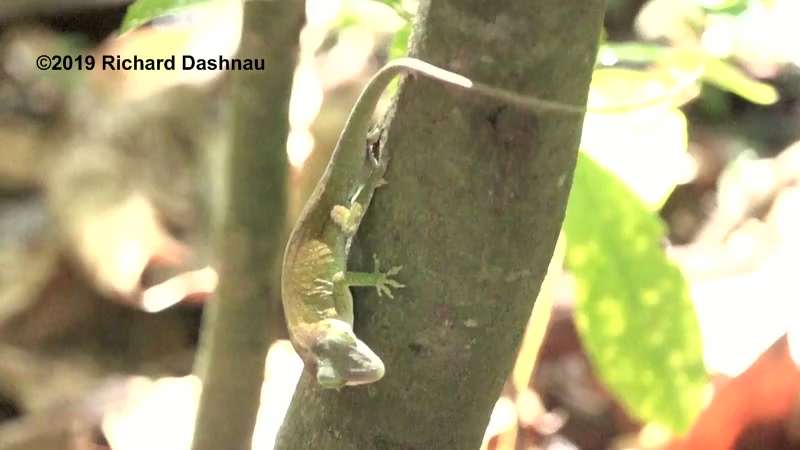
06/15/2019 I was
walking in Russ Pitman Park when I noticed movement in a patch
of sunlight on a log about 10 or 15 yards away. When I looked
through my binoculars, I discovered
that two Brown Anoles (Anolis Sagrei) where fighting. I started
shooting through the camera. I didn't catch the best part of the
conflict, but did get some interesting pictures. Once
again,
I noticed that both combatants had patterns of white dots among
white lines; and this doesn't appear to be their normal pattern.
Examine the images below to see what I am referring
to. I think this might be a "battle coloration". I also
shot a short video that is attached to this link. The third images below is a
frame-grab from this video. In that image, the "loser" (it
eventually retreated) is standing with a rear leg elevated. I
don't know if that signals submission, but it is a noticeable
posture. The submissive moved to the back end of the log and ran
off.
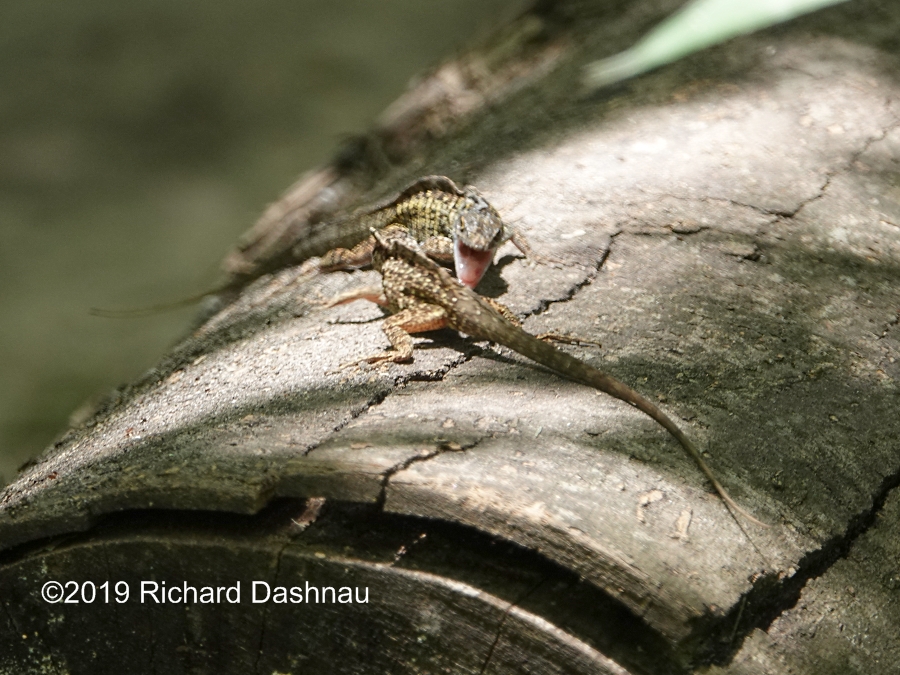
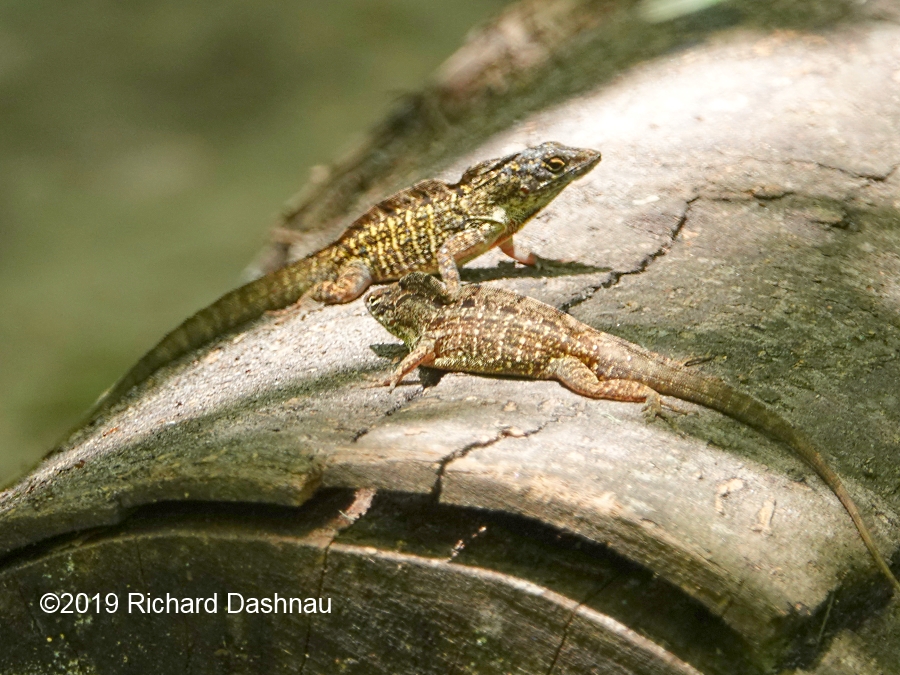
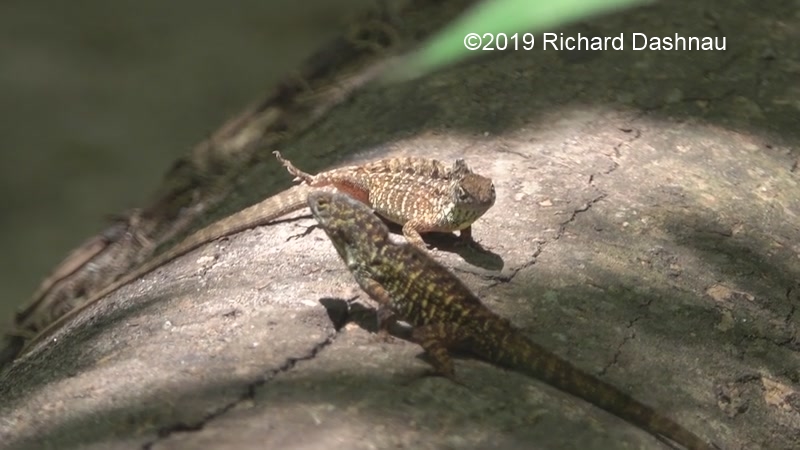
8/07/2016 While
walking along the Spillway Trail, I noticed this Skink sunning on a log.
It was about 4 inches long, and about 4 yards away. Skinks are
usually very
shy,so I snapped some
pictures from that distance away using as much zoom as I could. I moved on
without disturbing the Skink. After looking at 2 field guides
(Audubon Society Field Guide to North American
Reptiles and Amphibians; Peterson Field Guide to Reptiles and Amphibians
of Eastern and Central North America ), the best I can do is guess that
this is a 5-lined Skink (Eumeces fasciatus).
What I thought was best about this brief encounter was that the
Skink on the log was at a place on the trail where the water had been
about 6 feet deep during most of June. So, either the Skink
floated on the log during that time...or climbed one of the nearby trees.
In any case, it was there after the flood.
------------------------------------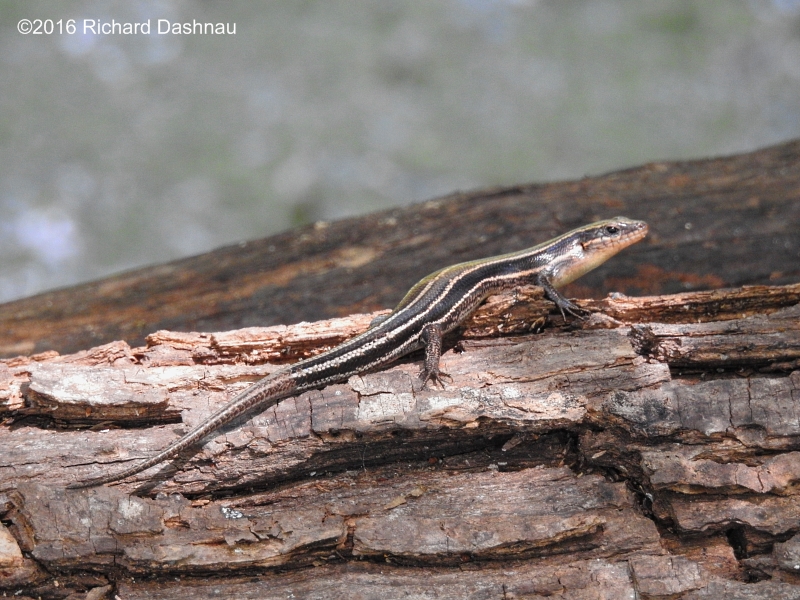
7/16/2016 While
outside at the Russ Pitman Discovery Center, I noticed something
light-colored moving in one of the trees about 20 yards away. It seemed to
be moving like a lizard does, so I
carefully walked over-so I wouldn't scare it-until I could see what was
going on. It was a Brown Anole shedding its skin. I decided to try to take
some pictures. I had trouble focusing my camera
in the contrasting shaded areas for photos, so I shot more video
than photos, and hoped to salvage some useful frames from the video.
Most of the images here are cropped from frames
grabbed from 1920 x 1080 video. To avoid scaring the Anole away, I stayed
about 8 feet away and used the optical zoom--without a tripod. The
two images below are from a single photo. I
happened to catch the Anole as it was pulling off one of its "socks"--the
molting from one of it's back feet.
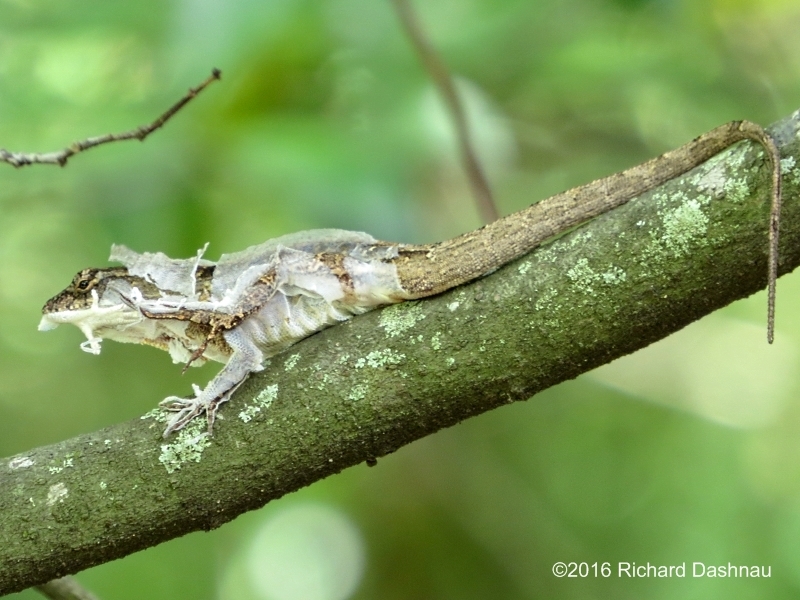 ---------------------
---------------------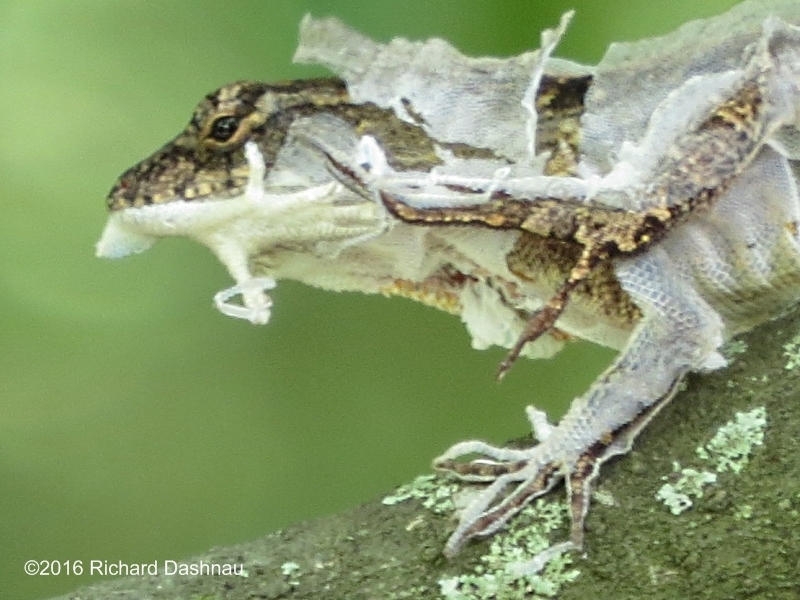
I was able to see a large portion of the molting process. The Anole pulled
bits of its old skin off, and ate them. Occasionally, the Anole extended
its dewlap. (As in the RICKUBISCAM picture)
Brown Anoles do this often, and it's hard to tell if they are always
extending a challenge to whatever lizards might be around...or everything
that might be around. It appeared here that maybe
the Anole was using it to help flex the *old* skin and tear it.I was lucky
enough to see the Anole pull off one "sock" and one "glove". It was
interesting to see how it carefully pulled the old skin
off of its toes. Once it got a good grip, it pulled on the skin ("sock" or
"glove") steadily, and slowly. It took about a minute and a half for
a single foot to be pulled free of the molted skin. By
contrast, bits of skin from other parts were pulled off rather quickly. I
was impressed by the patience and care showed by the Anole as it cleared
its toes of the old skin.
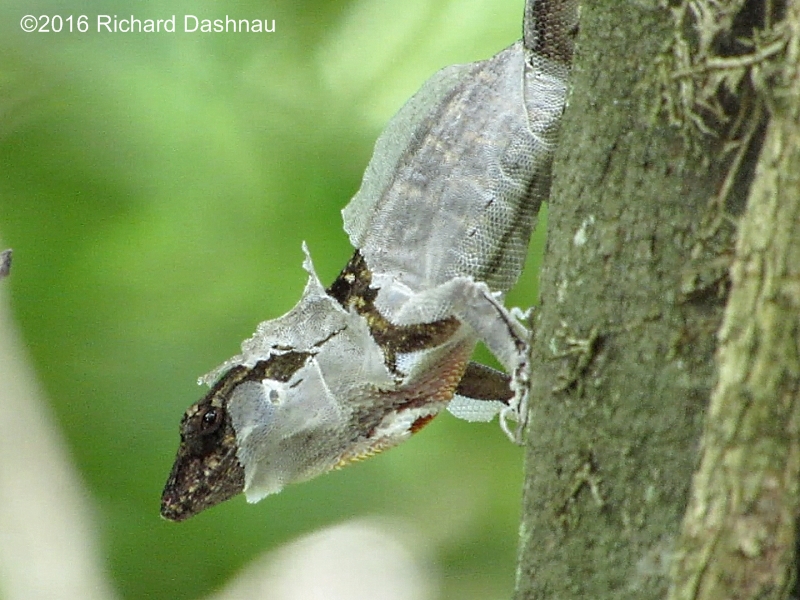
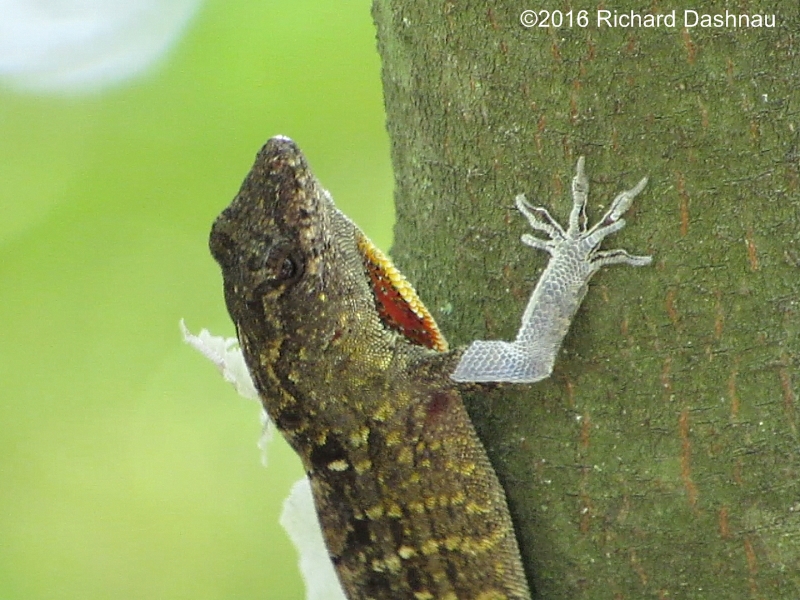
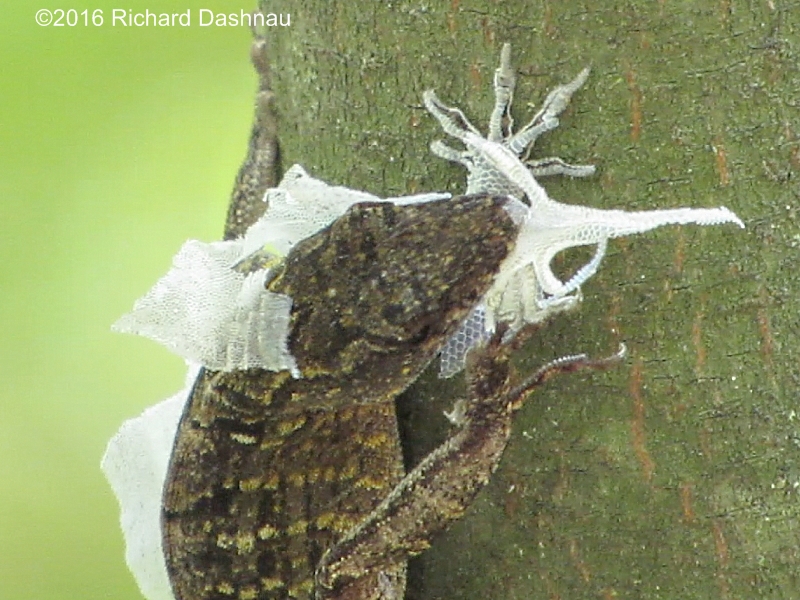
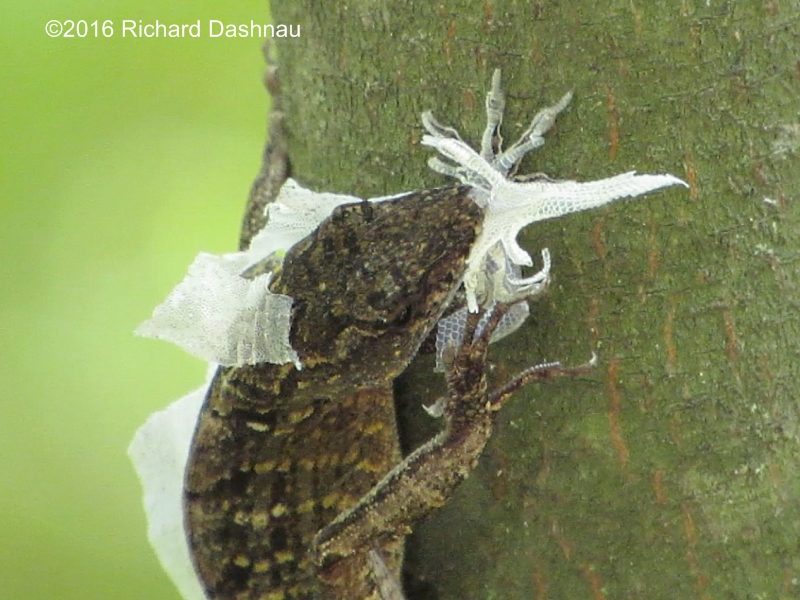
LOTS OF OLD SKIN
SHOWING ONE "GLOVE"
GRABBING ONE "SOCK"
PULLING THE SOCK...
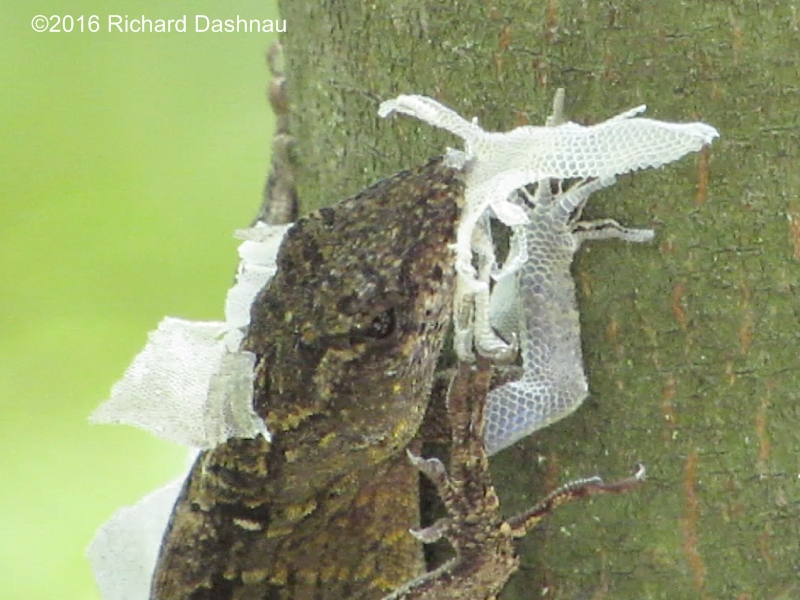
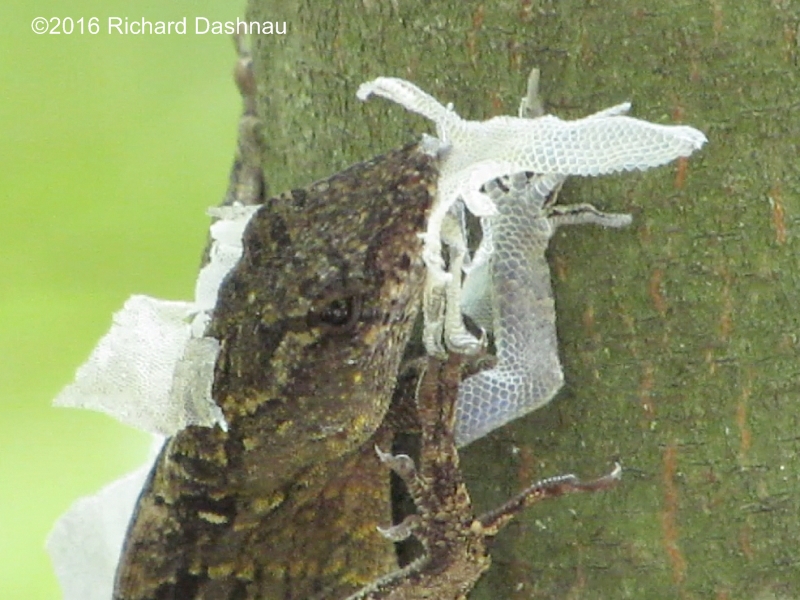
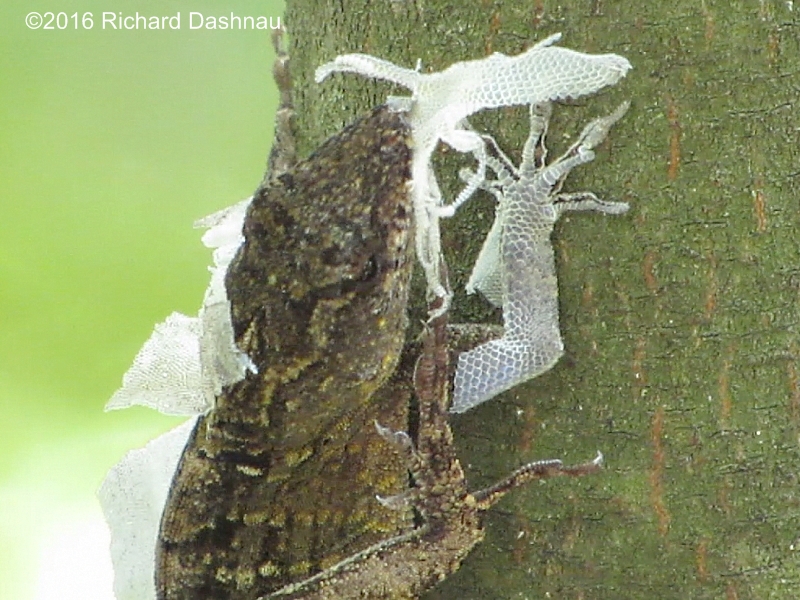
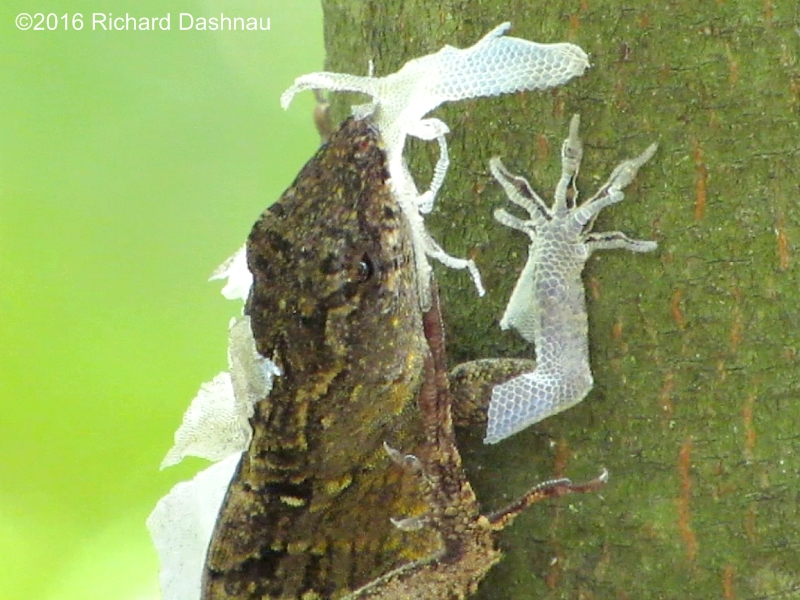
MOST OF THE FOOT IS FREE
STEADY, SLOW PULL
ALMOST OFF...ALMOST
JUST THE TIP IS LEFT
I can think of a few reasons for the care.
For one thing, the old skin has to come free of the hundreds of small
hairs on each of the Anole's toe pads. Does the old skin stick the the new
ones on the foot? Or, does the old skin have to
be pulled off of all of the new hairs (setae)--that is, does each new hair
shed a casing? For another, if the Anole isn't careful, it could tear the
old skin, and leave fragments stuck on its toe
pads, which would impede their clinging function. Also, how would it get
small fragments off its toes? The hairs stick through molecular
attraction. They can't be "turned off". Anoles unstick
their toe pads from climbing surfaces by curling their toes backwards to
unstick the hairs a few at a time. And another reason--an Anole is
probably strong enough to break its toes. It could
possibly cause injury to itself by hurrying.
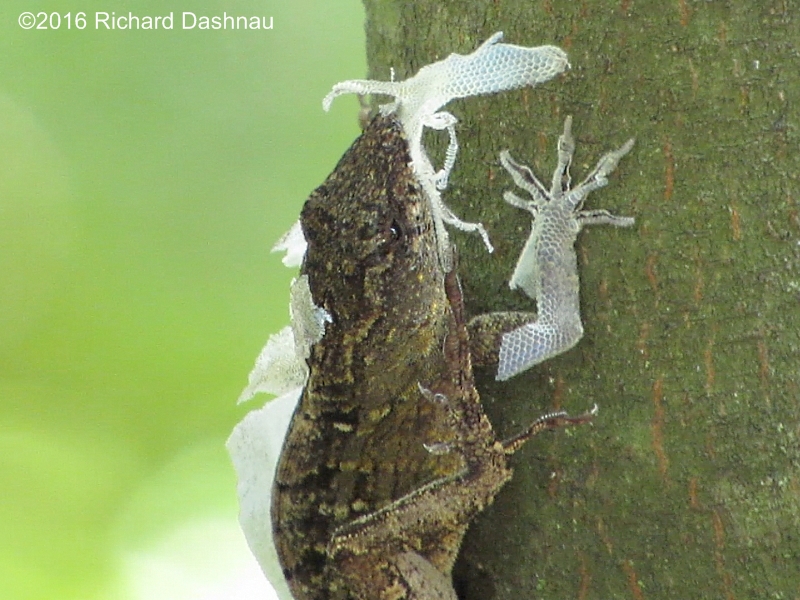
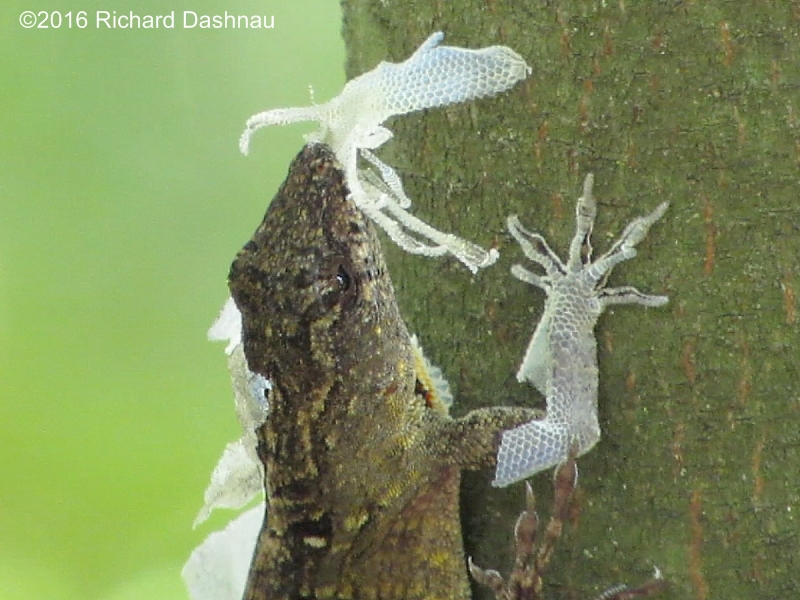
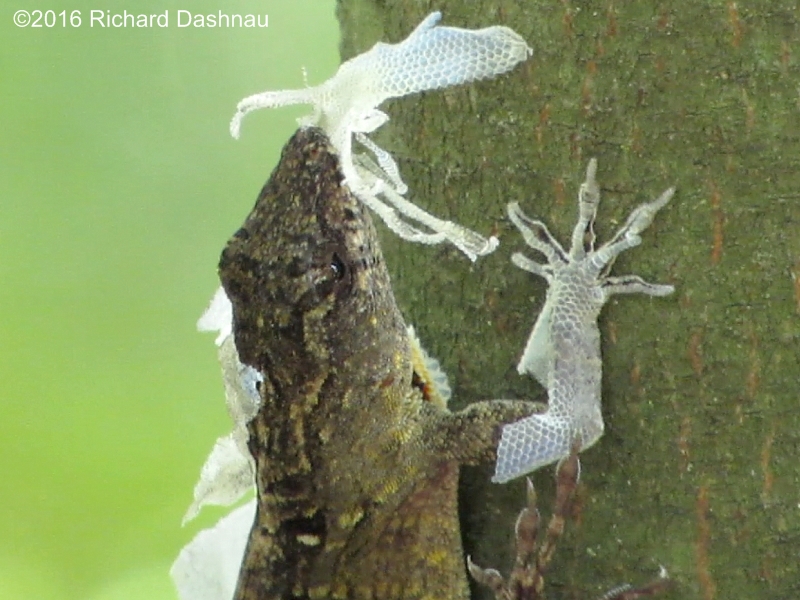
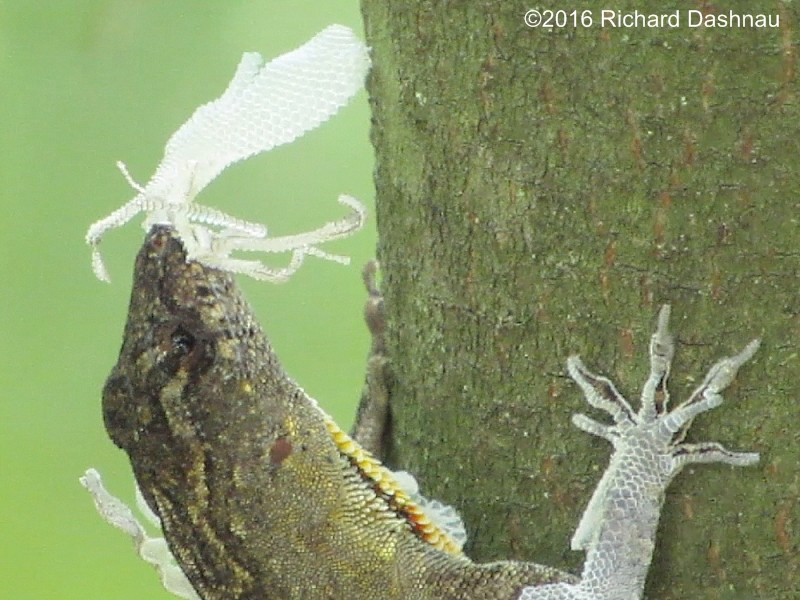
TOENAIL MUST BE STUCK
IT'S FREE!
NOW WHAT DO I DO WITH IT?
NICE, INTACT MOLTED FOOT
This is all guesswork on my part. I haven't found anything that describes
Anole molting in great detail. Brown Anoles (Anolis sagrei) are considered
an invasive species, and as I've mentioned
before; since the first time I heard of them being in the Houston area, I
have seen them in many places. I see them where I work, I see them where I
live. They are competing with the native
Green Anoles (Anolis Carolinensis) and seem to be driving them out of
their preferred habitat. But, something interesting might be happening.
The Green Anoles appear to be migrating *up*!
That is, they appear to be adapting to live higher in trees (maybe
up to 30 feet)--leaving the Brown Anoles to the ground, and lower plants.
This study: "Rapid evolution of a native species
following invasion by a congener" Y. E. Stuart,1*†‡ T. S. Campbell,2* P.
A. Hohenlohe,3 R. G. Reynolds,1,4 L. J. Revell,4 J. B. Losos seems to
indicate that as time passes (and a surprisingly
short time...a few years),the Green Anoles' foot-pads are becoming
better-suited for clinging to the larger smooth surfaces (such as leaves)
at the higher altitudes. The Anoles are developing
more clinging surfaces on each toe! So the home team is still in the
game. To see video of this
Anole molting, click the link here.

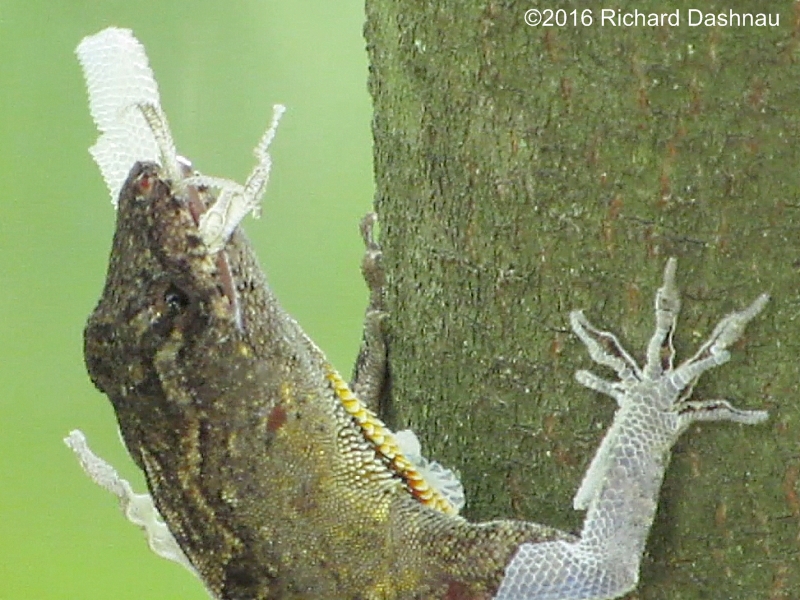
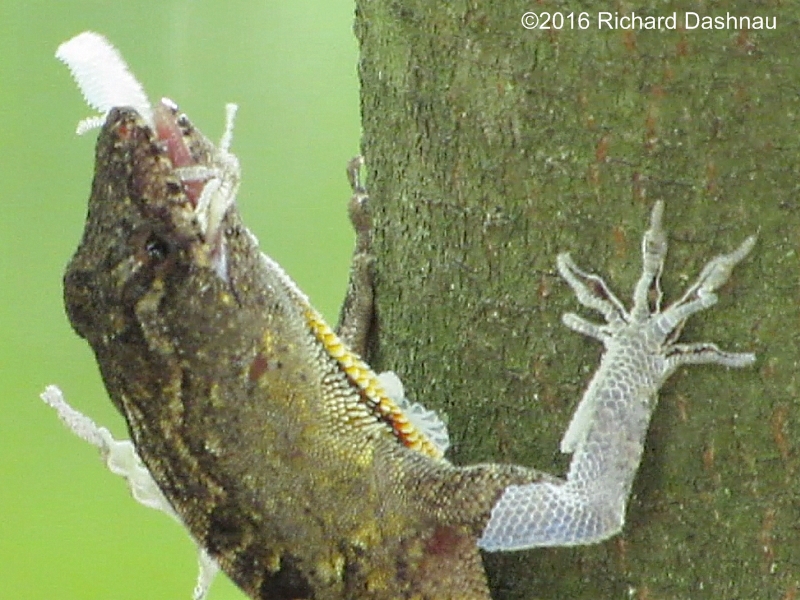
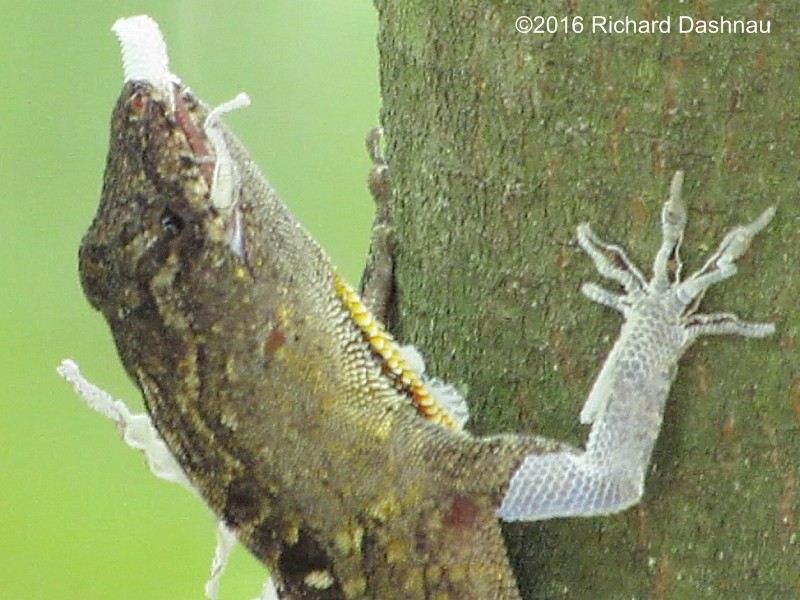
CHOMP!
CHOMP!
AND THERE IT GOES.
CHOMP!
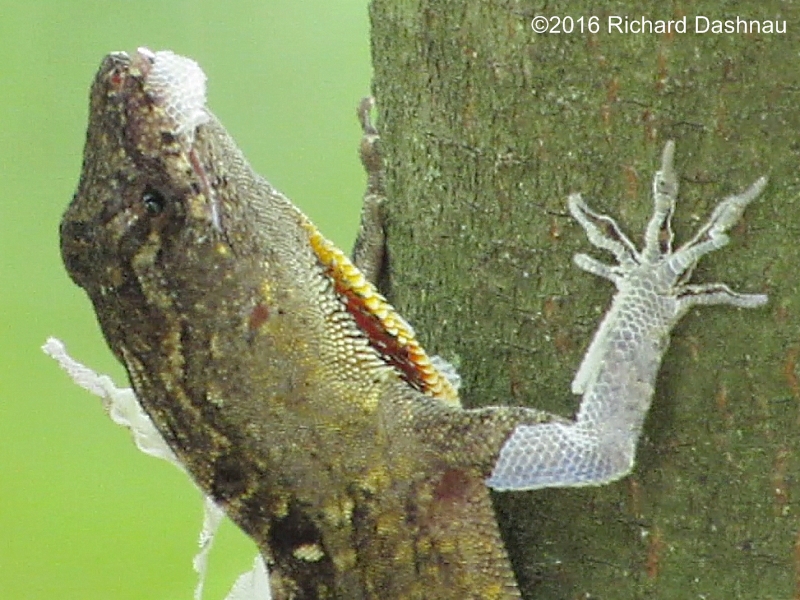
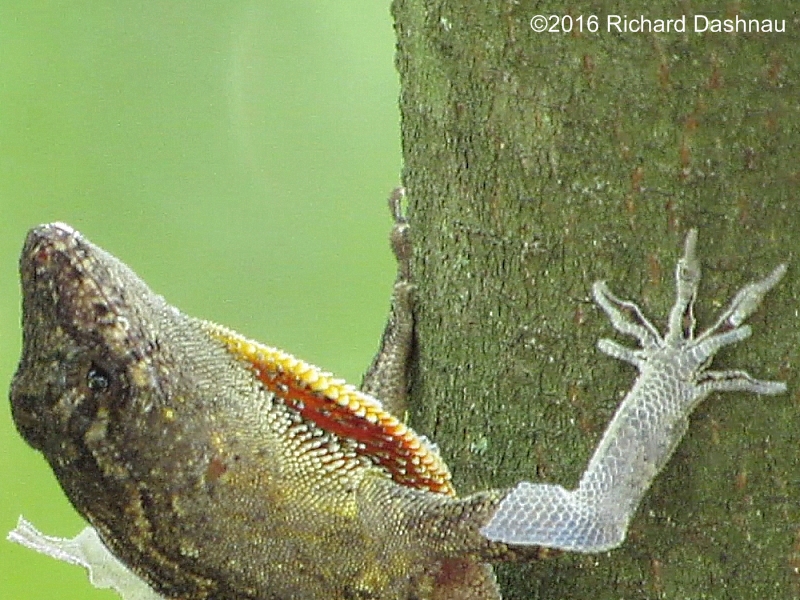
THERE IT GOES.
BUT THE JOB ISN'T DONE.
MORE MOLTING TO FINISH.
May 01 2013 (update 07/16/2020)
Like
almost everyone these days, I've been staying inside. I
have stopped driving around outside
for...recreational purposes. So I'm catching up on old
material. On
May
01, 2013, I visited Russ Pitman Park. This is an old house and a
small park. I liked to go there because I lived nearby,
and it was a surprisingly good place to find
wildlife-especially Anoles. I could still find Green
Anoles (Anolis carolinensis) there although invasive Brown
Anoles (Anolis sagrei) were getting more common. I saw a number
of interesting
things, but I'll talk about this one. It was a good day
to watch anoles (I've already posted about 2 different anole
species together that day. I took more pictures with a different
camera. I
didn't realize then how the Brown Anoles would overrun
everything. I found many Green Anoles at the park that
day. Here are some that posed while I took their pictures.
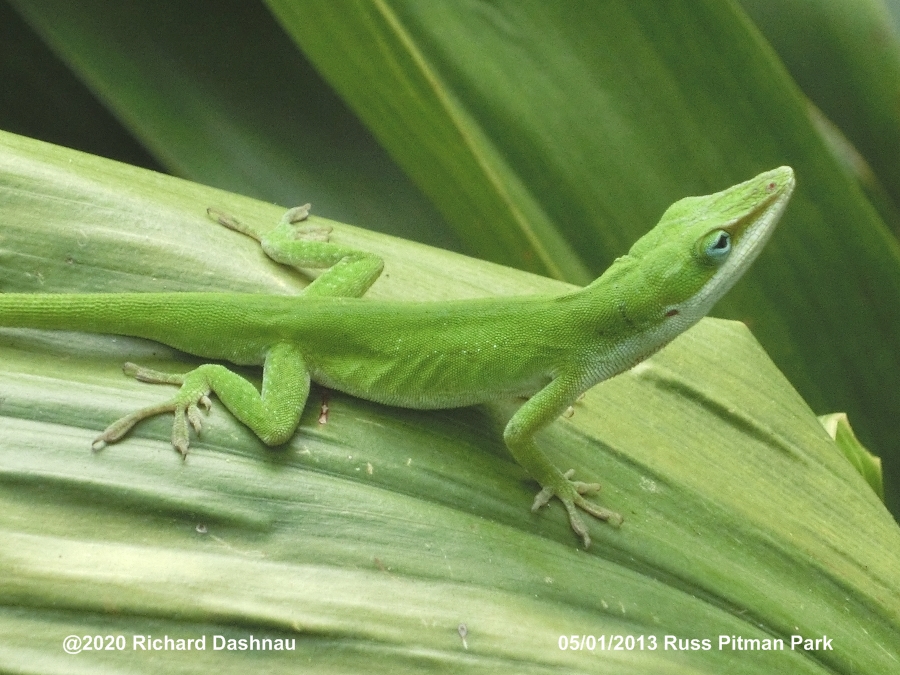
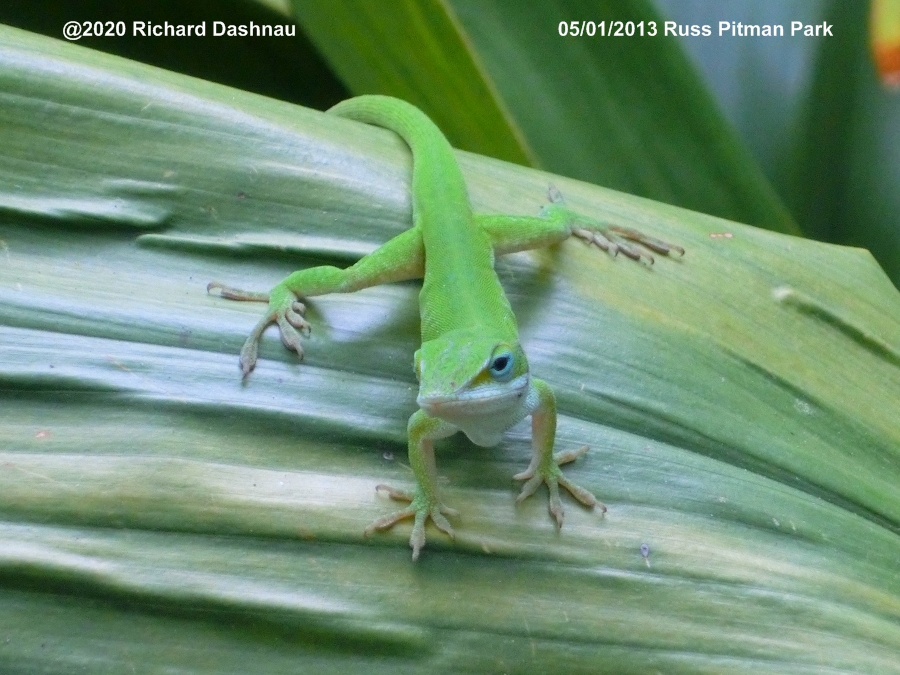
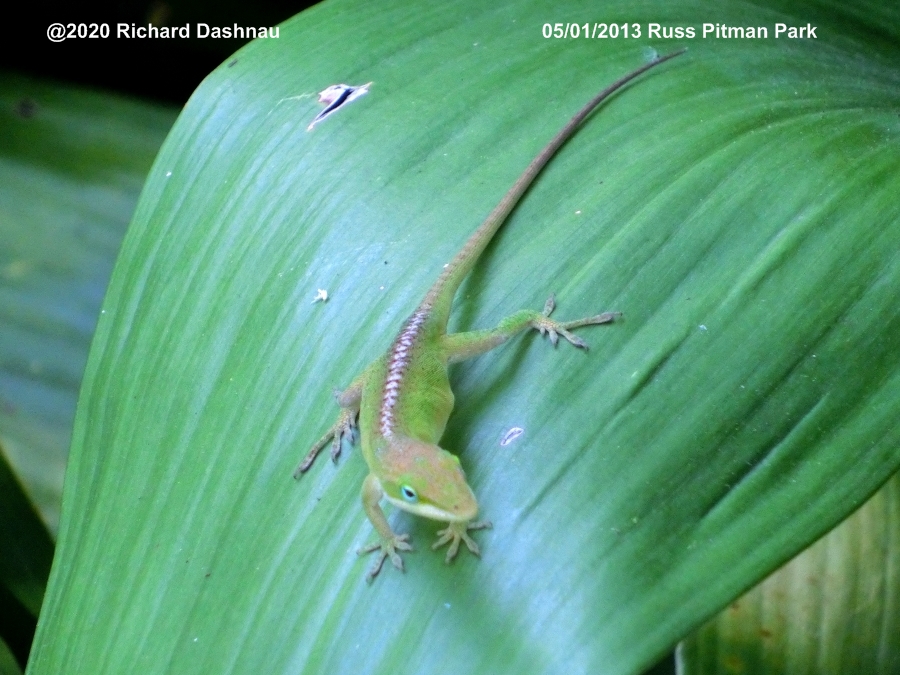
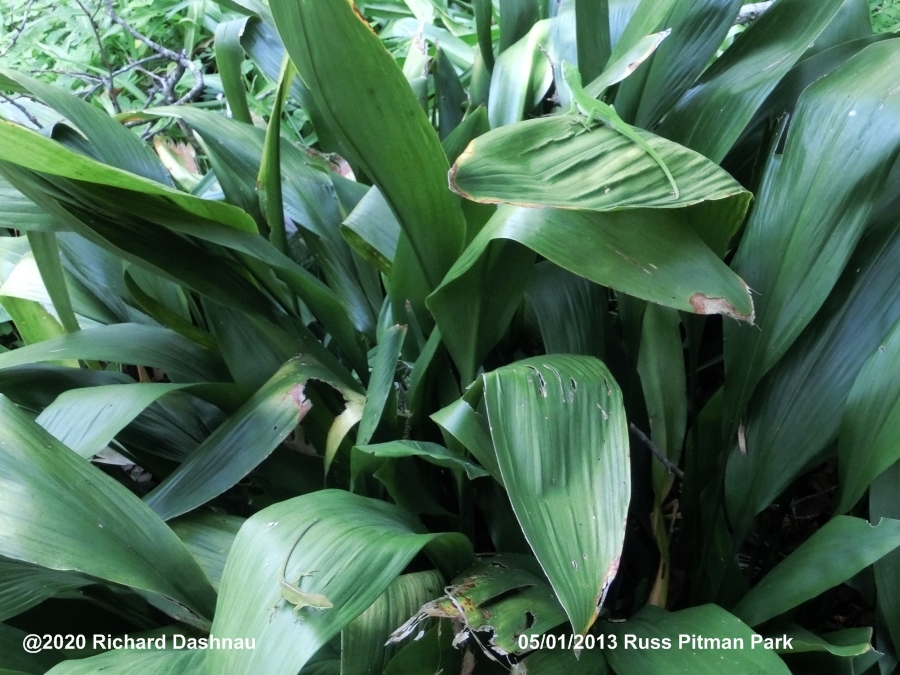
A male. Note
the large toe pads.
Another
male.
A female
A male and a female. Can you find them?
Then I started
filming a male as he began to move around, showing his dewlap. I
discovered that he...had a date! I captured some video of
this male as he met a female and moved
into cover--presumably so they could start making more anoles.
The video was originally filmed at 240 fps at 512 x 384
resolution. I can expand that at least to 640 x 480 without
losing much clarity--so I've done that. I've edite the clips
together, and sped up many of them to show actual pace of movement
. The
images below are frames from the video
clip that can
be seen here.
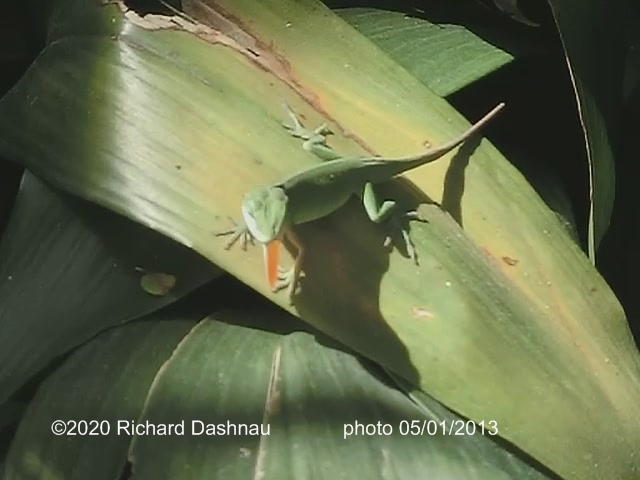
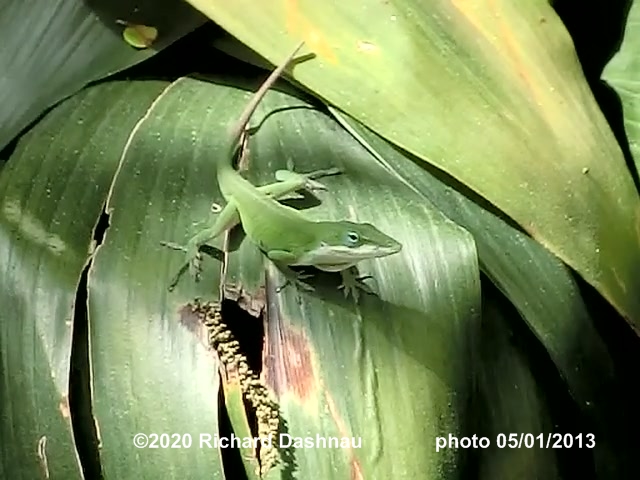
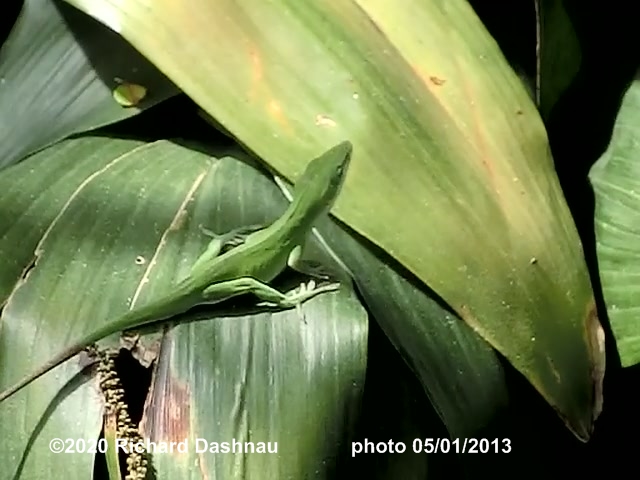
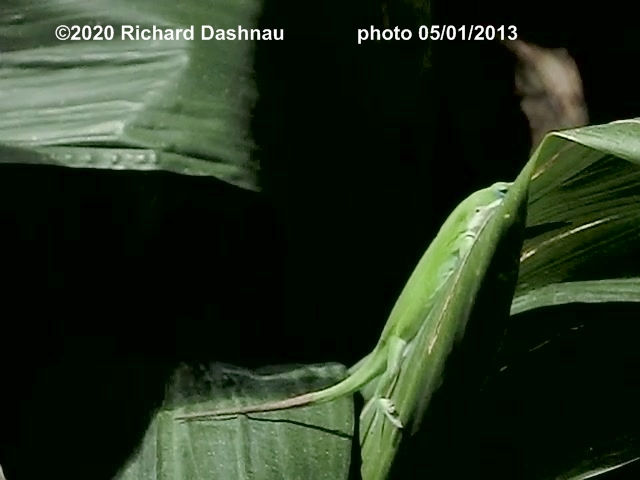
1 Signalling
w/dewlap
2 looking
around
3 preparing to leap
4
after the
leap
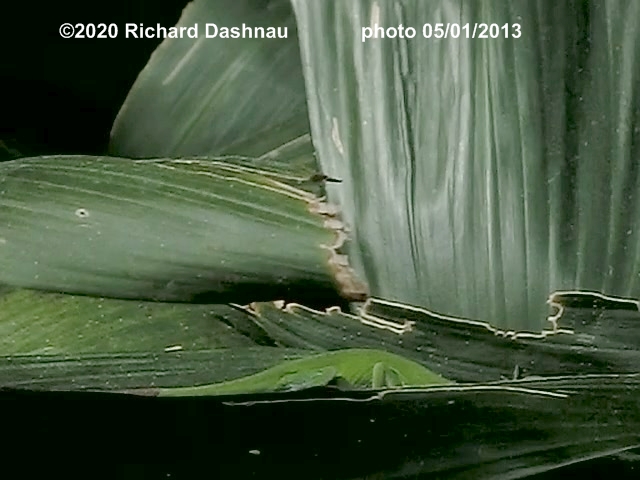
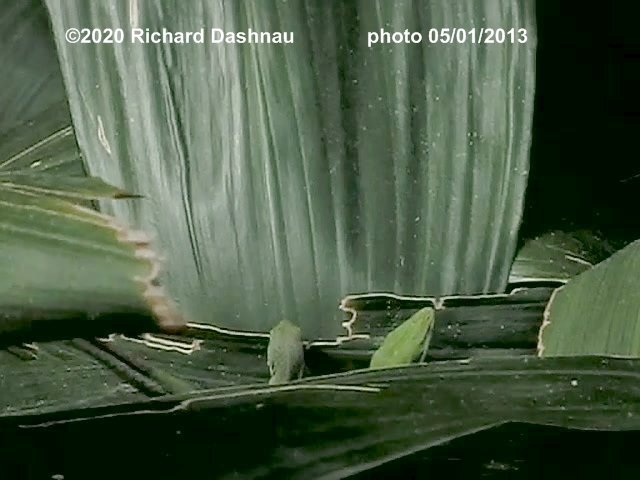
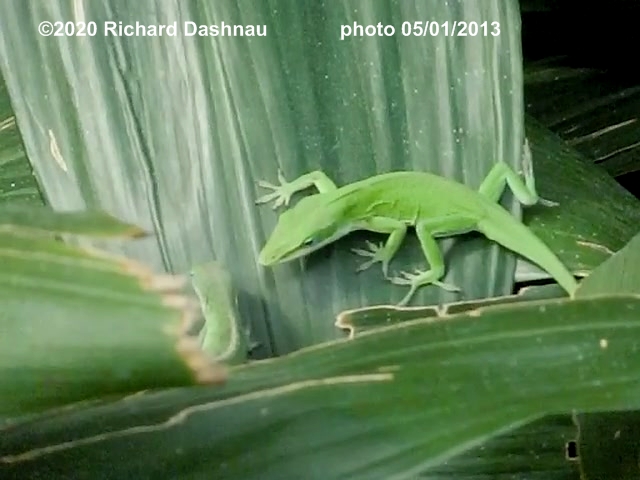
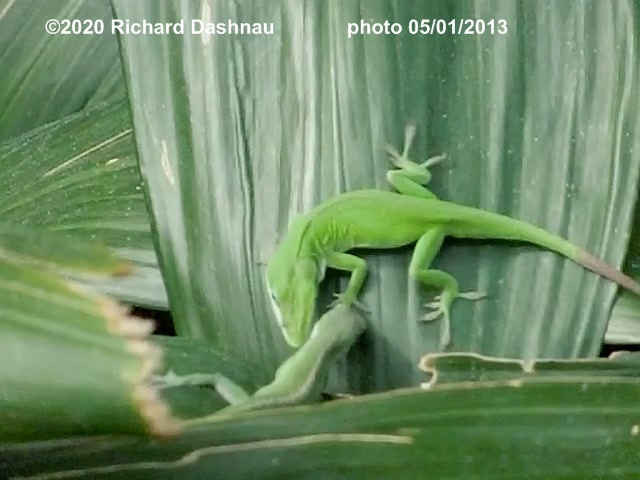
5 what's
he after down there?
6 A
female is there!
7
8
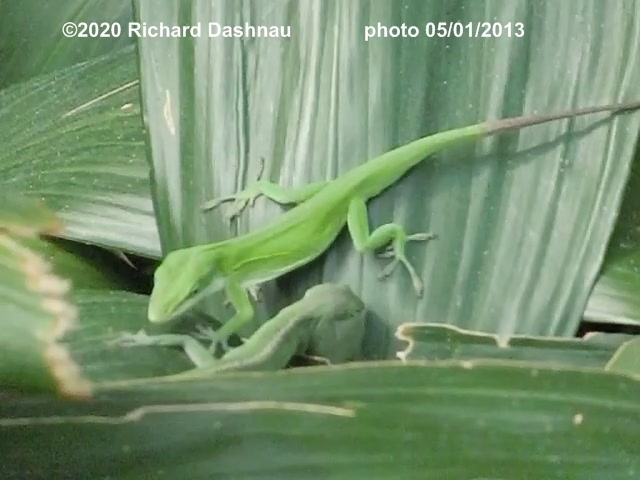
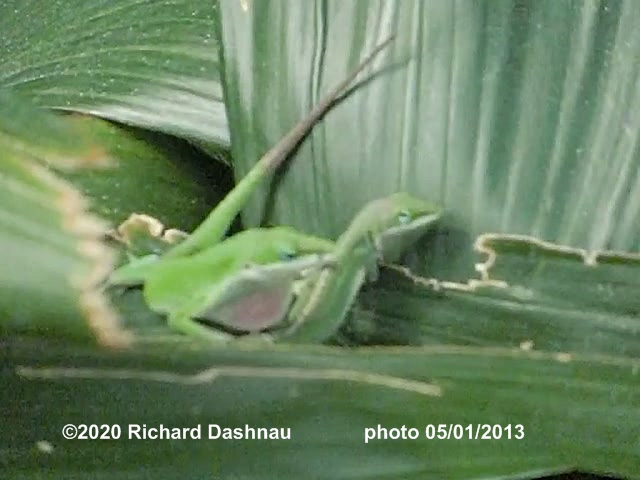
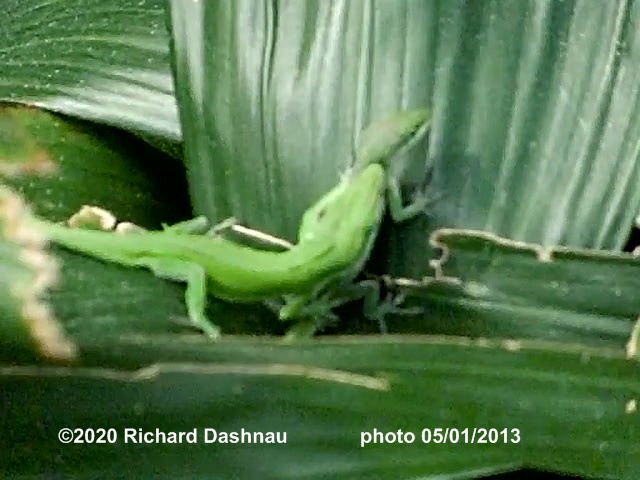
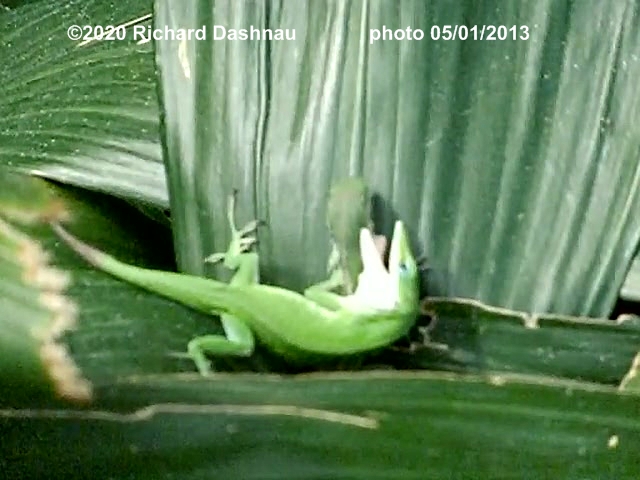
9
10 dominance
display?
11
12 He
tried to...nip at her.
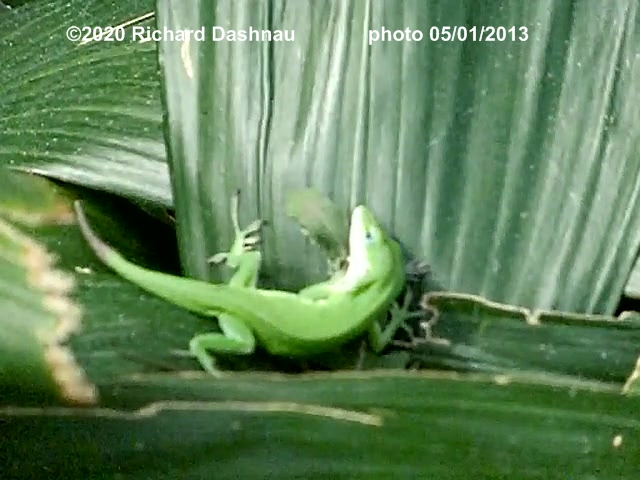
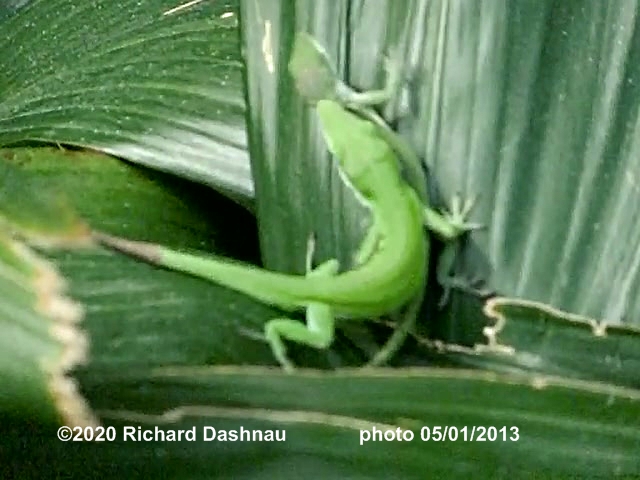
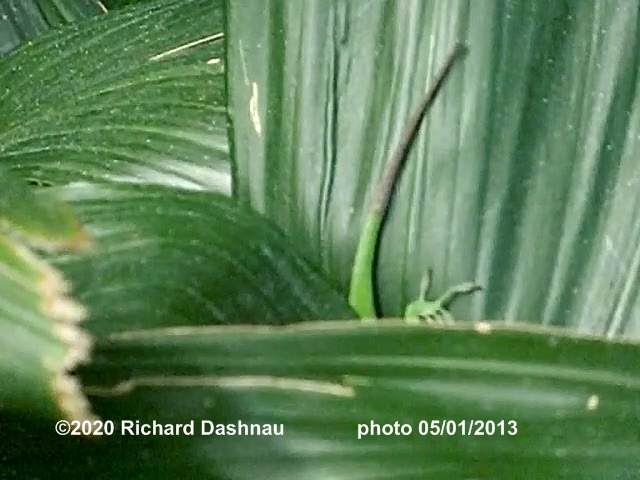
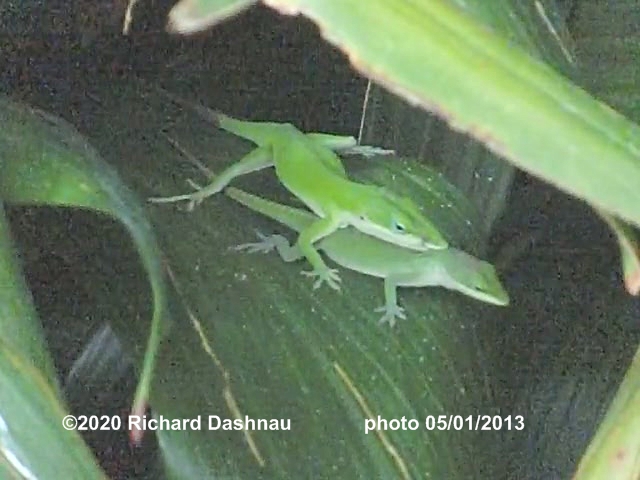
13 He
missed, tried again
14 Finally,
he grabbed skin behind her head.
15 Off for some safety.
16
But I found them.
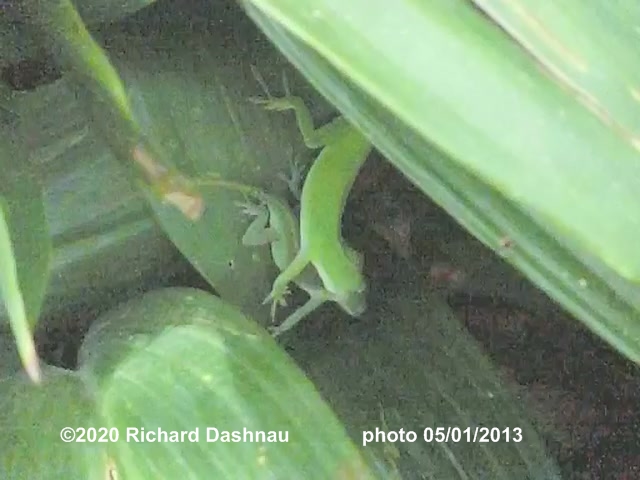
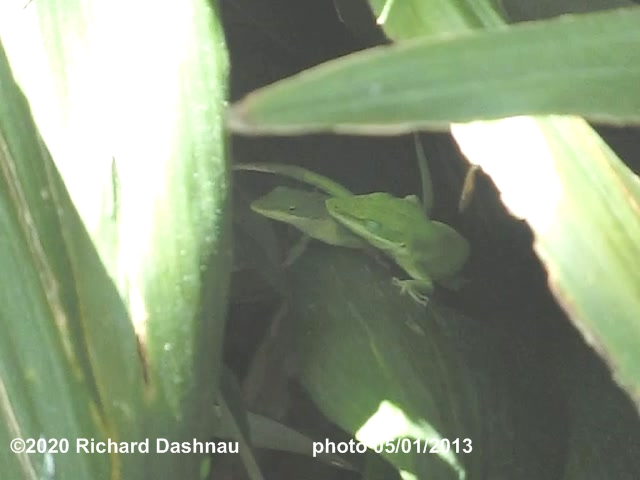
17
He
still had a grip on her skin.
18
I
left them alone after this.
May 01 2013 (update 07/05/2020)
Like
almost everyone these days, I've been staying inside. I
have stopped driving around outside
for...recreational purposes. So I'm catching up on old
material. On
May
01, 2013, I visited Russ Pitman Discovery Center. This is an old
house and a small park. I liked to go there because I
lived nearby, and it was a surprisingly good place
to find wildlife-especially Anoles. I could still find
Green Anoles (Anolis carolinensis) there although invasive Brown
Anoles (Anolis sagrei) were getting more common. I saw a number
of
interesting things, but I'll talk about this one. I
noticed a Brown Anole on some railroad ties at the garden. It
was broadcasting (bobbing, flaring dewlap) from that vantage
point. I looked
around to find out if any other lizards would react or respond.
When I looked back at the broadcaster, I discovered that
he had a challenger. And...it was a Green Anole! A
different species
was challenging him! The entire drama took just a few
minutes. I took photos, and shot video at 30fps high
resolution and at 120 fps at 640 x 480. Most of the video
was shot in the last
format, and I didn't think it showed enough. But, software has
changed a lot since 2013 (today it's 2020), and I was able to
enhance the video. The images below are from photos, and frame
grabs from the various video clips. I've also edited the
clips together into a single video that
can
be seen here.
First 8
pictures: The first display, and the appearance of the
challenger. Note that the challenger has lighter color and
a longer skull than the original Brown. Also, that fiery red
dewlap helps
identify a Brown Anole.
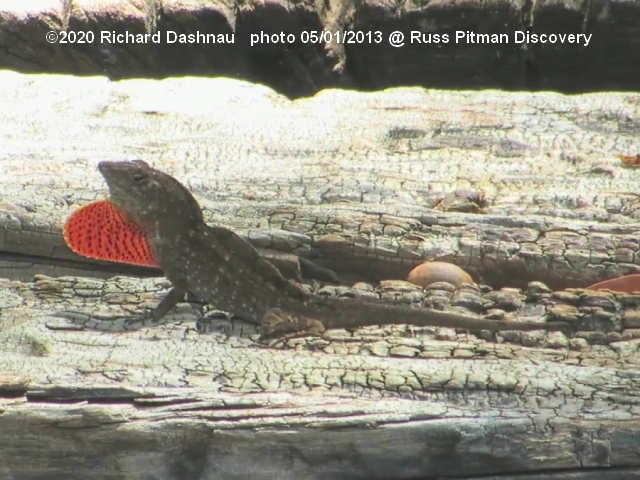
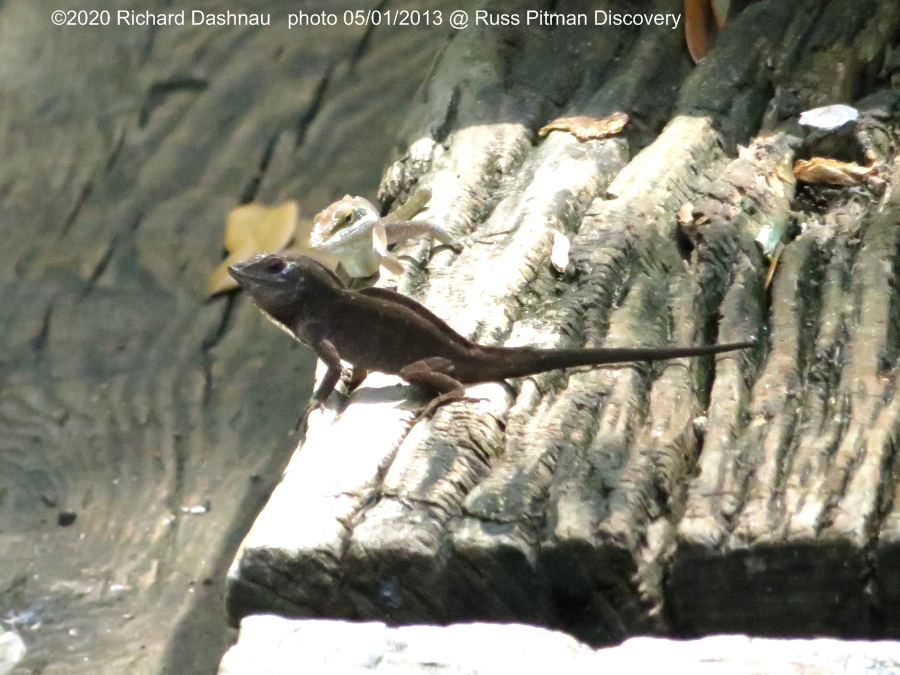
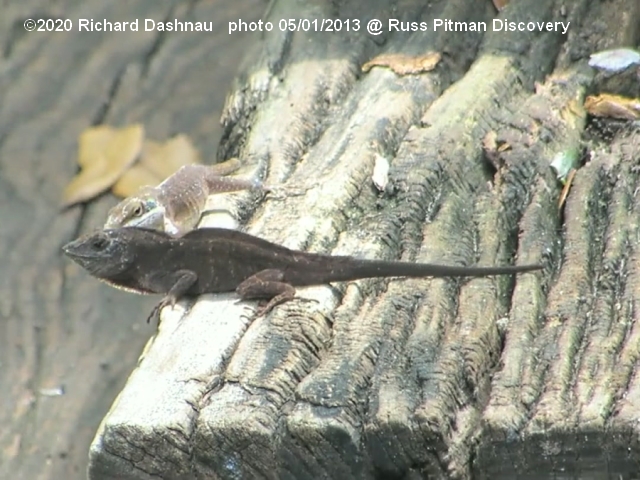
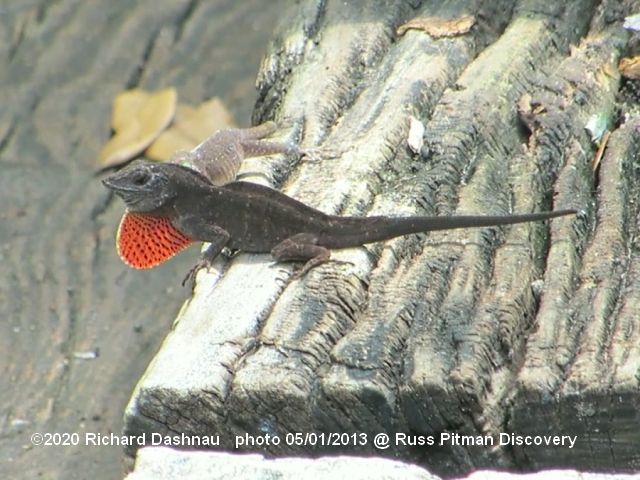
1 5/01/2013
2
5/01/2013
3 5/01/2013
4 5/01/2013
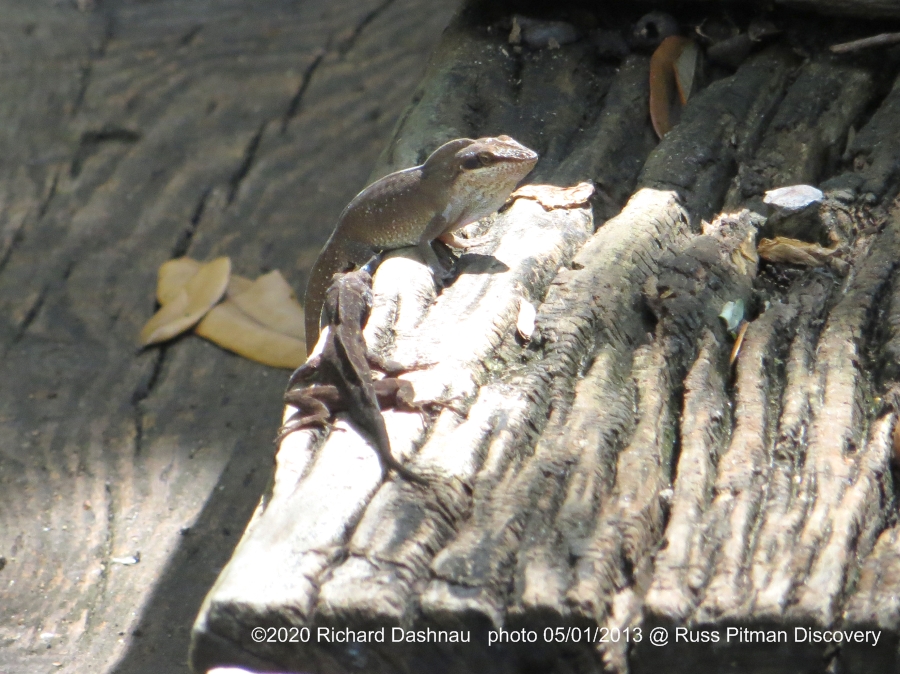
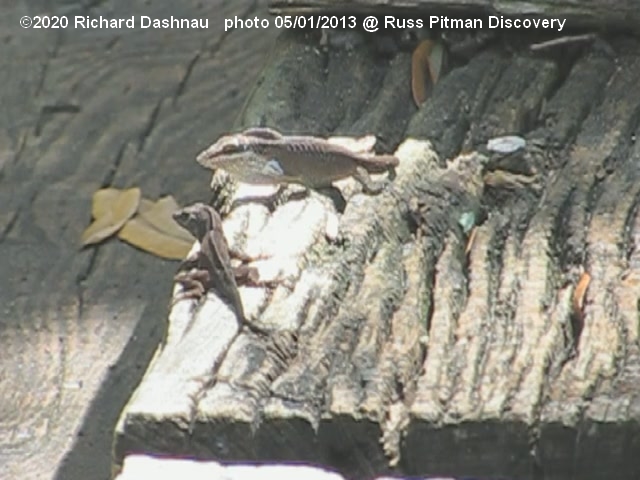
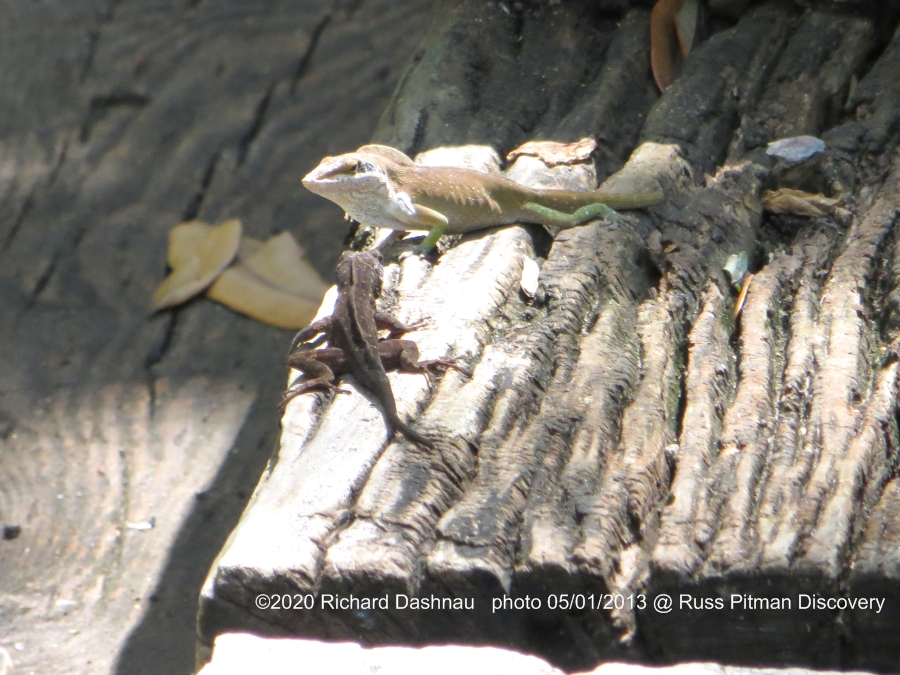
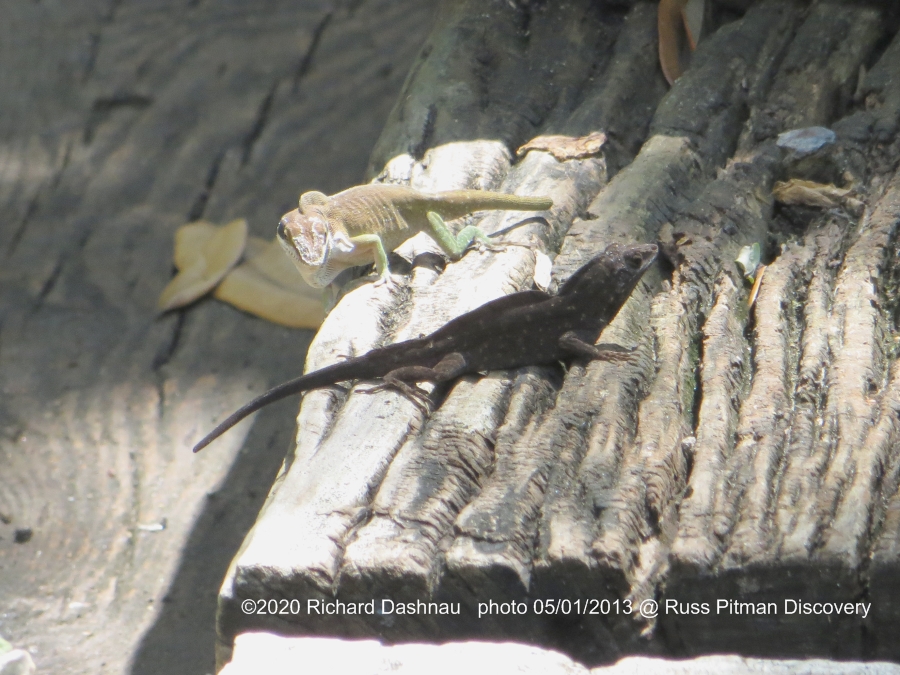
6 5/01/2013
7 5/01/2013
8 5/01/2013
8 5/01/2013
Next
4 pictures: The Green walks over and past the Brown. Now it
has become a much lighter green. Also, the black battle colors
show on the sides of the Green Anole's head.
Both of these males have had their tails broken off at some time.
Both of their tails show that they've been regenerated. Are they
both old warriors?
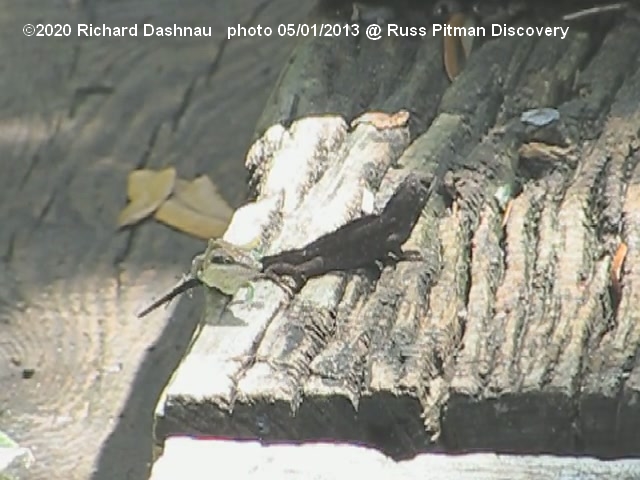
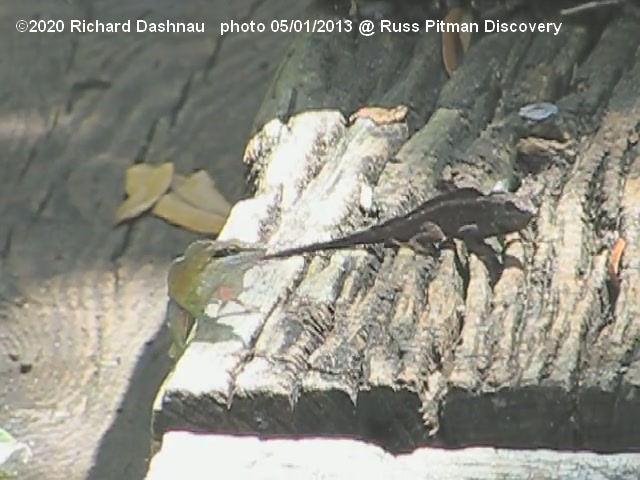
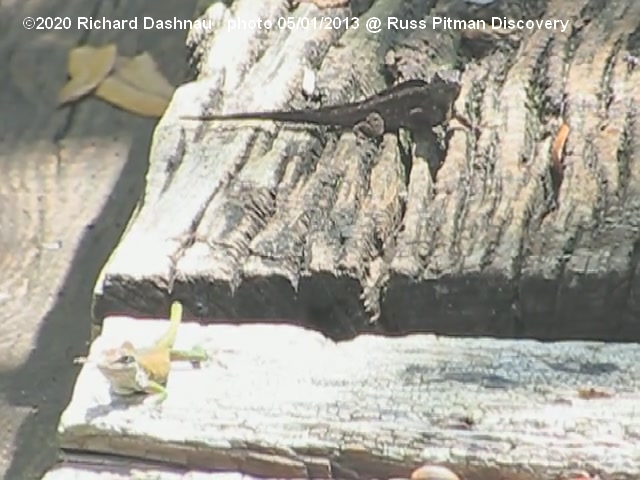
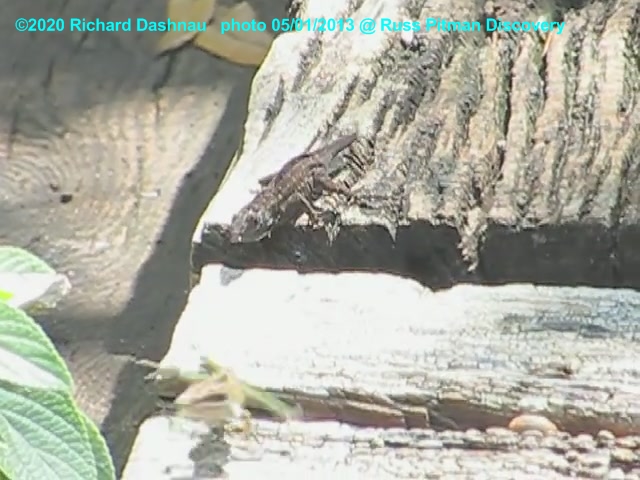
9 5/01/2013
10 5/01/2013
11 5/01/2013
12
5/01/2013
Last 4 pictures: The Brown had
challenged the Green (image 12 above right). The Green
answered, and finally showed its dewlap. Green Anoles have a
pink dewlap. This one seemed
to be deformed. Usually it has a more expanded shape. The
Green moved towards the Brown . They both rested a bit,
and then challenged again. The Green finally retreated
into
into the foliage. Once again: I've
edited the clips together into a single video that
can
be seen here.
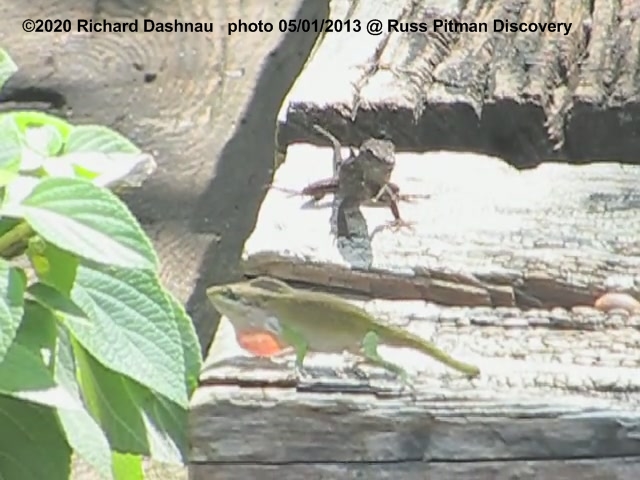
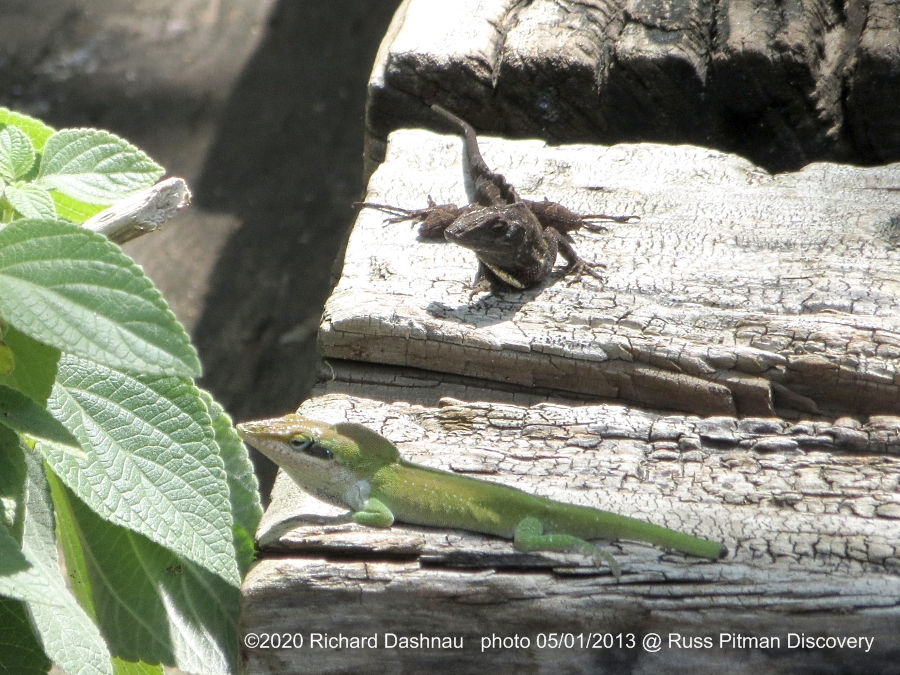
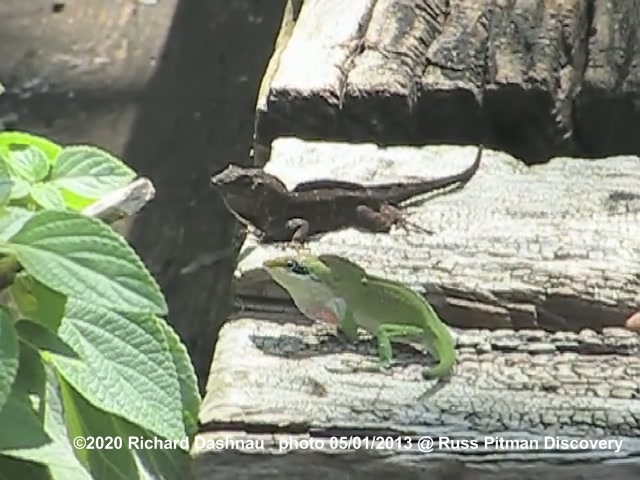
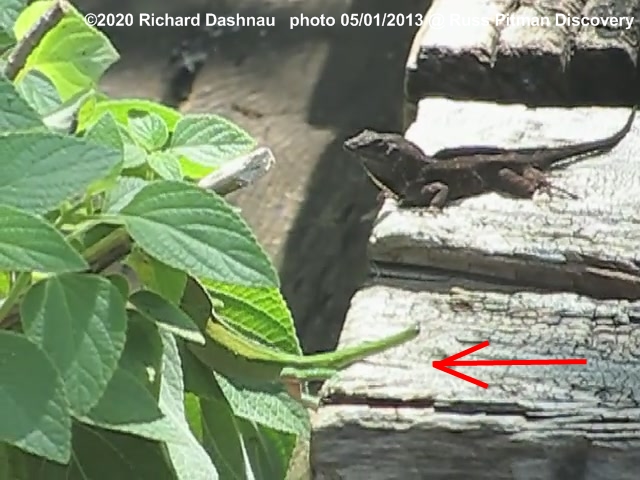
14 5/01/2013
15 5/01/2013
16
5/01/2013
17 5/01/2013
I have reqd-in a number of sources-that Brown Anoles are driving
the Green Anoles out of their original homes. I've read that
some of this is due to competition for food, and possibly
the young Greens being eaten by the Browns. At least one
study indicates that this environmental pressure is driving the
Green Anoles up
so that they are living in higher branches.
This is also possibly driving physiological adaptations in the
Green Anoles--such as wider toe pads with more setae...the very
tiny hairlike structures that allow them to cling to smooth
surfaces. I haven't seen anything written about
actual physical confrontation between them. It's
interesting to think that they might be competing for mating
territory, also.
Go
back to my home page, Welcome to
rickubis.com
Go
back to the RICKUBISCAM
page.




























































































































